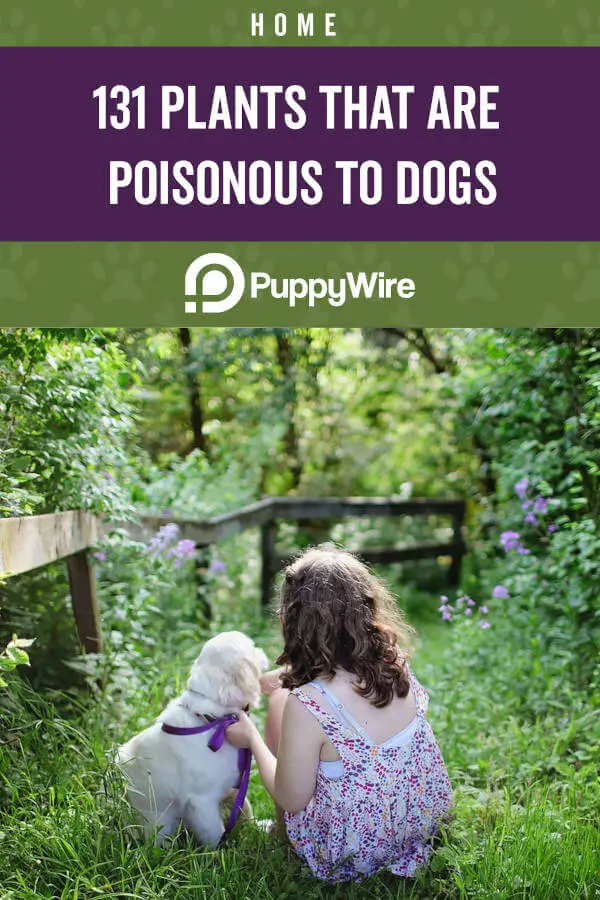131 House, Garden, and Wild Plants That Are Poisonous to Dogs

Knowing which plants can be harmful to your dog is very important.
I encountered this topic after moving into a new house with landscaping plants I knew nothing about. The dogs really were interested in checking them out but I kept them away due to the fear of not knowing if they were safe or not. Hence why I decided to put this list together.
Since the list is so large, we have divided it up into 3 sections (garden plants, house plants, and wild plants).
We spent many hours into researching the content and images. Please let us know if this was helpful to you.
List of Garden Plants That Are Poisonous to Dogs
Amaryllis

Scientific Name: Amaryllidaceae
Level of Toxicity to Dogs: Mild to Moderate
Common Symptoms to Watch For: Vomiting, Drooling, Nausea, Abdominal Discomfort, Respiratory Distress
Amaryllis plants has different variety of names like belladona lily, jersey lily, march lily, amarillo. These plants are flowering bulbs and common in gardens. The bulb of the amaryllis plant is the most dangerous part of the plant which can cause gastrointestinal distress, lethargy and tremors.
Angel's Trumpet
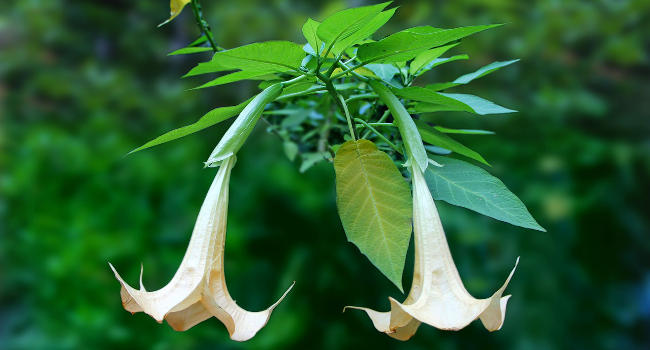
Scientific Name: Brugmansia
Level of Toxicity to Dogs: Severe
Common Symptoms to Watch For: Lethargy, Hyperactivity, Vomiting, Hyperthermia, Seizures
The Angel's Trumpet has many other names such as moon flower, jimson weed, thorn apple, and indian apple. Although this is very pretty and quite common in gardens, it is very toxic to dogs. You need to watch very closely since every part of the Angel's Trumpet is toxic especially the seeds. It does produce a fragrance that most dogs don't seem to like and they tend to keep their distance.
Apple Leaf Croton
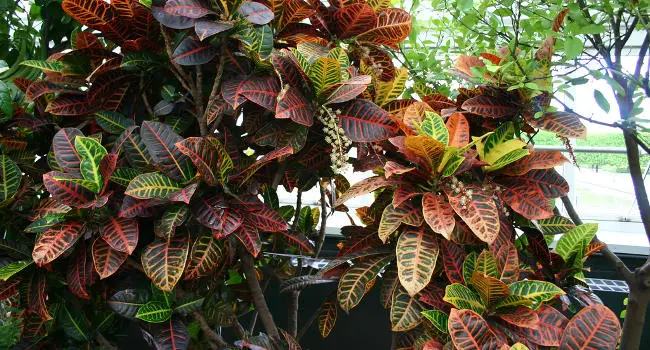
Scientific Name: Codiaeum variegatum
Level of Toxicity to Dogs: Mild
Common Symptoms to Watch For: Vomiting, Drooling, Diarrhea, Skin Irritation, Eye Irritation
The apple leaf croton is a house plant that is popular because of it's colorful leaves. These plants has chemicals called diterpenes which are usually found in the bark, roots and sap of the plants. The chemical is not considered fatal to dogs but can still cause irritation and swelling of the mouth. If a dog has ingested one of the parts of the plant it can cause vomiting and diarrhea.
Azalea

Scientific Name: Rhododendron
Level of Toxicity to Dogs: Severe
Common Symptoms to Watch For: Vomiting, Drooling, Diarrhea, Abdominal Pain, Hypotension
Azaleas have a potent neurotoxin called grayanotoxin. Azalea poisoning if ingested can lead to serious health issues. Symptoms are generally abdominal pain, coma, depression, diarrhea, excessive drooling, hypotension, lethargy, loss of appetite, low blood pressure, shallow breathing, seizures and vomiting.
Bleeding Hearts
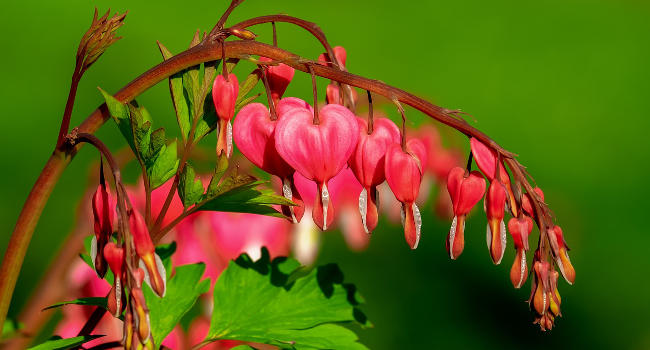
Scientific Name: Lamprocapnos spectabilis
Level of Toxicity to Dogs: Mild to Moderate
Common Symptoms to Watch For: Vomiting, Diarrhea, Tremors, Staggering, Respiratory Issues
The bleeding hearts also known with many names such as dutchman's breeches, squirrel corn, white eardrops, steer's head, soldier's cap, butterfly banner, and staggerweed. These plants have a very distinct flower and vary in color. The bleedings hearts has a toxin called isoquinoline alkaloids. The toxin which are mostly found in the roots and foliage, if ingested can cause permanent damage to their liver and kidney if not flushed out in their system quickly.
Boxwood Tree

Scientific Name: Buxus sempervirens
Level of Toxicity to Dogs: Severe
Common Symptoms to Watch For: Vomiting, Diarrhea, Abdominal Pain, Lethargy, Inability to Walk Straight
The boxwood tree commonly seen on gardens as dividers for other plants. These plants or tree are harmful to dogs mainly because of the alkaloids it contains. The whole boxwood tree is toxic as dogs could get poisoned through ingesting and exposure of the tree to the dogs skin. Exposure to the skin causes redness, irritation and itching. Eating any part of the tree will result to vomiting, diarrhea, dizziness and possible respiratory failure even death if not treated immediately.
Branching Ivy (aka English Ivy, Needlepoint Ivy)
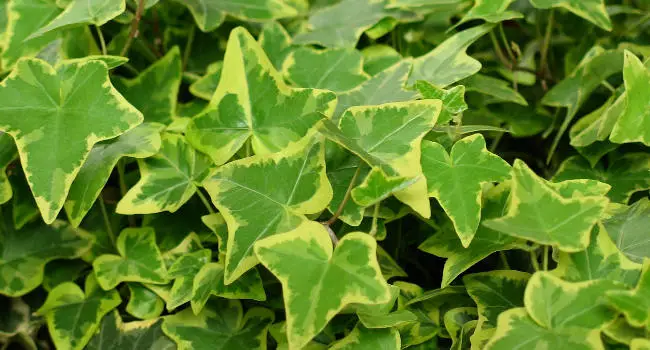
Scientific Name: Hedera helix
Level of Toxicity to Dogs: Mild to Moderate
Common Symptoms to Watch For: Vomiting, Drooling, Diarrhea, Abdominal Pain, Pawing at the Mouth
The Branching Ivy also known as English, glacier, needlepoint, sweetheart and California Ivy. These plants contain a toxin called saponin glycoside. This toxin, which is found all over the plant, if consumed can cause gastrointestinal symptoms like diarrhea and vomiting leading to your dog to be dehydrated and, at worst, respiratory symptoms that could be fatal. A dog's skin can also be exposed by the plant or dust from the ivy that causes irritation. It is advisable if you see your dog eating from the ivy bring your dog to the nearest veterinarian or animal hospital immediately.
Buddhist Pine
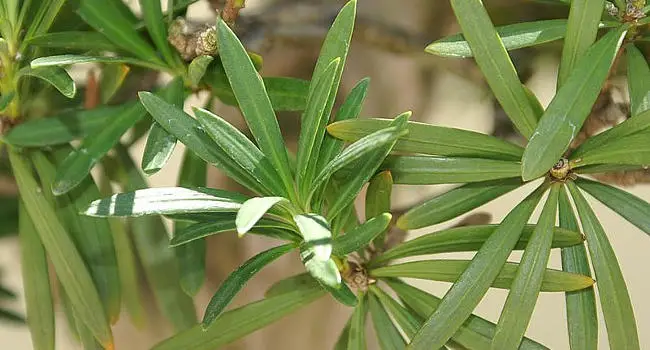
Scientific Name: Podocarpus macrophylla
Level of Toxicity to Dogs: Mild to Moderate
Common Symptoms to Watch For: Vomiting, Diarrhea, Abdominal Pain, Drooling, Enlarged Pupils
The Buddhist Pine also known as yew plum pine, fern pine, Japanese yew and southern yew. These plants are believed to be yew trees but they are not. The Buddhist Pine can be lethal to dogs if not treated immediately. The entire part of the tree is toxic and depending on which part of the plant they have eaten and how many they consumed depends on how much are they in danger. Symptoms to watch out for are diarrhea, drooling, enlarged pupils, vomiting and abdominal pain but if they are having difficulty breathing seizures or having tremors immediately rush the dog to your nearest animal hospital as they are likely to be dehydrated from vomiting.
Burning Bush
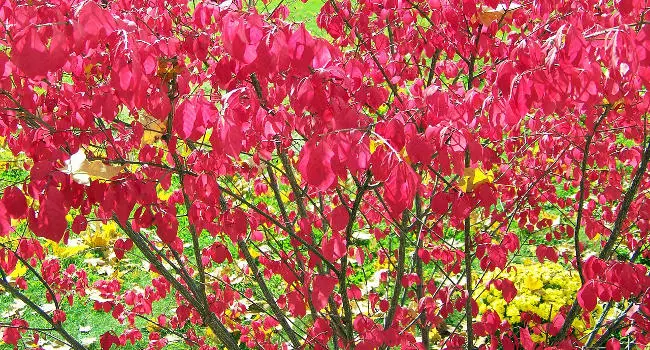
Scientific Name: Euonymus atropurpurea
Level of Toxicity to Dogs: Mild to Moderate
Common Symptoms to Watch For: Vomiting, Diarrhea, Abdominal Pain, Weakness, Heart Rhythm Abnormalities
The Burning Bush also known as wahoo, summer cypress, strawberry bush, and spindle tree. Alkaloids and cardiac glycoside are all over the plant and causes the dog to be poisoned if consumed. The plant is extremely bitter tasting so many dogs will leave it alone. The toxins found in the plant may not show immediately but if absorbed by their body may cause severe symptoms like seizures, abdominal pain and having problem breathing.
Chrysanthemum

Scientific Name: Chrysanthemum spp
Level of Toxicity to Dogs: Mild
Common Symptoms to Watch For: Vomiting, Diarrhea, Coughing, Drooling, Lack of Appetite
Chrysanthemum also known as mums or daisies are natural insecticides and if consumed by dogs can cause drooling, coughing, vomiting, lack of appetite, agitation and shaking.
Clematis

Scientific Name: Clematis spp
Level of Toxicity to Dogs: Mild to Moderate
Common Symptoms to Watch For: Vomiting, Diarrhea, Drooling
The clematis is one of those plants that if in full bloom is gorgeous but this beautiful plant is toxic to dogs. One of the main reason it is poisonous to dogs is because of the present of glycoside protoanemonin. These toxins are all over the plant especially the leaves that can cause problems in their digestive system if ingested. Although the plant is bitter and should deter dogs from eating a large amount you still should be careful around this plant. If your dog happens to eat the plant contact your veterinarian immediately. It is also found that the flowers and vines can cause dermatologic reaction.
Croton (aka Miniature Croton)
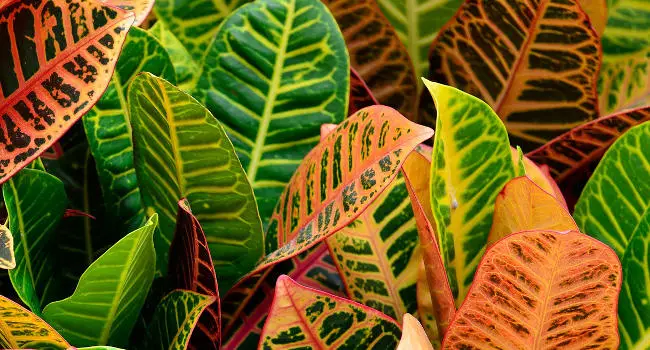
Scientific Name: Codiaeum variegatum
Level of Toxicity to Dogs: Mild
Common Symptoms to Watch For: Vomiting, Diarrhea, Drooling, Skin Irritation, Eye Irritation
The croton also known as apple leaf croton is a house plant that is popular because of it's colorful leaves. These plants has chemicals called diterpenes which are usually found in the bark, roots and sap of the plants. The chemical is not considered fatal to dogs but can still cause irritation and swelling of the mouth. If a dog has ingested one of the parts of the plant it can cause vomiting and diarrhea.
Daffodil (aka Narcissus)

Scientific Name: Narcissus spp
Level of Toxicity to Dogs: Mild to Moderate
Common Symptoms to Watch For: Drooling, Nausea, Vomiting, Diarrhea, Abdominal Pain
These plants are commonly found during spring. Daffodils contain lycorine that can cause dangerous arrhythmias from cardiac changes. One of the most common part that causes daffodil poisoning to dogs are the bulbs if ingested because they contain the most potent toxin. Also, the dust from the bulbs is quite harmful when inhaled by dogs which causes coughing spasms and wheezing. These plants are also harmful to your dog’s skin as it may cause blisters, inflammation and itching.
Daphne
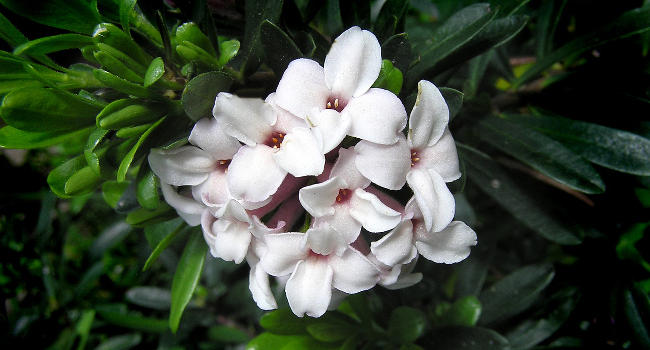
Scientific Name: Daphne odora
Level of Toxicity to Dogs: Mild to Moderate (Possibly Severe if ingested a large amount)
Common Symptoms to Watch For: Vomiting, Drooling, Blistering of the mouth, Diarrhea, Abdominal Pain
The Daphne has many kinds, and can also be referred to as dwarf bay or paradise plants. Daphne has prostratin and glycoside that causes poisoning to dogs. Every part of the plant is poisonous to dogs especially the berries as it has more concentration of the poison. A dog can be poisoned by exposure of the skin and even the eyes but the scariest part of daphne poisoning is ingestion or eating the berries as it could cause severe diarrhea and dehydration that could be fatal if not treated immediately. Luckily the berries taste bitter so dogs could deter from eating the fatal amount.
Dieffenbachia (aka Dumbcane, Spotted Dumbcane, Tropic Snow Dumbcane)
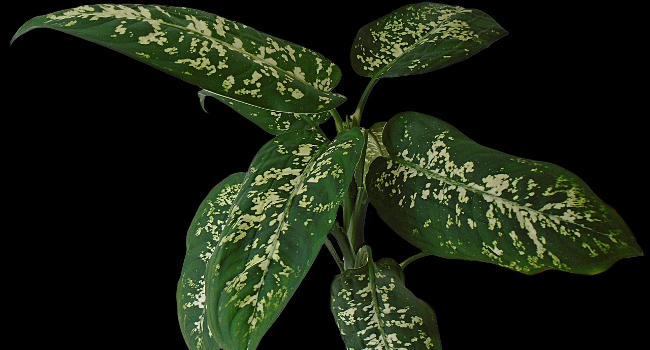
Scientific Name: Dieffenbachia
Level of Toxicity to Dogs: Mild to Moderate
Common Symptoms to Watch For: Drooling, Pawing at the mouth, Oral Pain, Decreased Appetite, Vomiting
Dieffenbachia also known as dumb cane is a popular houseplant because of its beautiful mix of green, white, yellow foliage. These gorgeous plants though is poisonous to dogs and should never be in their reach. The toxin found all over the plant are needle shaped calcium oxalate crystals that causes irritation and pain in their mouth when chewed, diarrhea and vomiting if ingested, eye irritation if exposed.
Some dogs may have allergic reactions that if not treated right away will be fatal. Dogs should be treated right away if you see your dog chewing or eating these plants.
Some treatment that will help the pain in their mouth is by giving them a cold water to drink and rinsing their mouth with water to remove the crystals. If ingested or consumed visit a veterinarian to help the dog get treated right away, it is not advice to treat these type of poisoning by yourself.
Emerald Feather (aka Asparagus Fern)
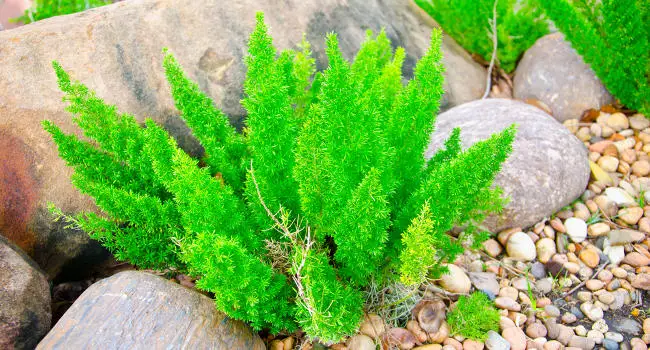
Scientific Name: Asparagus densiflorus
Level of Toxicity to Dogs: Mild to Moderate
Common Symptoms to Watch For: Vomiting, Abdominal Pain, Diarrhea
The Emerald feather also known as asparagus fern is a house plant and also can be found in the gardens. The toxin found in these plants are called sapogenin which are found in the berries. The berries if swallowed or ingested by dogs can cause gastrointestinal distress, vomiting and diarrhea. The sap of the plant can cause the dog's skin to have blistering, redness and swelling.
Flamingo Plant



Scientific Name: Anthurium
Level of Toxicity to Dogs: Mild to Moderate
Common Symptoms to Watch For: Oral irritation, Pain and Swelling of the mouth, Drooling, Vomiting, Difficulty Swallowing
The Flamingo plant is a gorgeous looking plant that are popular with gardeners and use in homes as it doesn't require much sun to thrive. The plant is extremely toxic to dogs and cats as it contains insoluble calcium oxalate. The toxins are found in any part of the plant and dogs that chews or eats the plant will suffer intense pain in their mouth and if intgested could cause difficulty in breathing as swelling of the oral area would block air. Symptoms will occur immediately and if a dog have ingested this toxic plant contact your veterinarian ASAP.
Gladiolas


Scientific Name: Gladiolus communis
Level of Toxicity to Dogs: Mild to Moderate
Common Symptoms to Watch For: Drooling, Vomiting, Lethargy, Diarrhea
Gladiola or gladiolus also common name "many cultivars" is a popular perennial plant that can be very toxic to dogs especially the bulb part. These plants can cause cardiac symptoms like arrhythmia if a large amount of bulbs are eaten by the dog. It has also been known to cause liver and kidney symptoms.
Glory Lily (aka Gloriosa Lily)
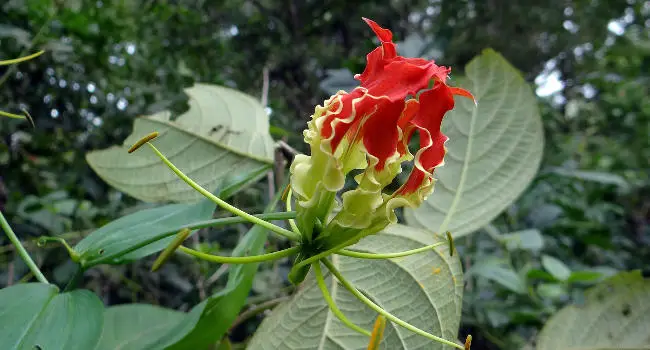

Scientific Name: Gloriosa
Level of Toxicity to Dogs: Severe
Common Symptoms to Watch For: Seizures, Vomiting, Kidney failure, Liver failure, Diarrhea
The Glory Lily plant like any other poisonous lilies the plant is known to be one of the most toxic in their family. The Glory lily can cause life threatening poisoning within hours of ingesting. The plant is toxic in any part but the tube or root is where the poison is more concentrated. The poison found in this plant is called calchicine alkaloids that destroys blood cells that leads to organ failure. Ingesting or consumption of the plant is the way the poison can get in to their system so be aware if your dog is anywhere near these plants. If a dog eats even just one tube or root of this plan symptoms it could be dangerously fatal and need to be check by a veterinarian immediately.
Gold Dust Dracaena (aka Florida Beauty)
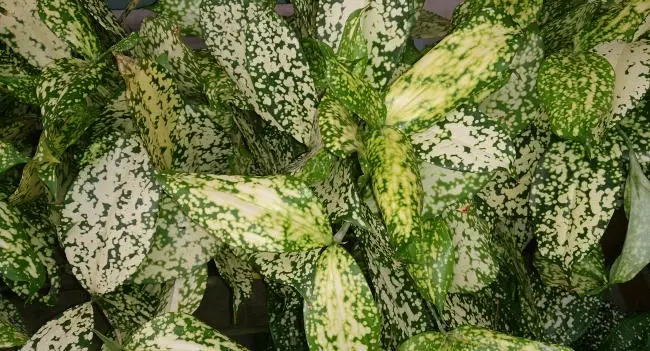

Scientific Name: Dracaena surculosa
Level of Toxicity to Dogs: Mild to Moderate
Common Symptoms to Watch For: Drooling, Vomiting, Diarrhea, Abdominal Pain, Weakness
The Gold Dust Dracaena also known as Florida beauty is a common houseplant and sometimes could be seen in offices. The plant is dangerously toxic to dogs depending on how much they have ingested. The toxic found in the plant are called steroidal sapnonin which are found in any part of the plant but the it is more concentrated in the berries. Poisoning can be mild to moderate by consuming any part of the plant and depending of the amount it can be extremely toxic especially if the berries are eaten. As it can cause increase heart rate and loss of control over bodily movements.
Golden Chain Tree
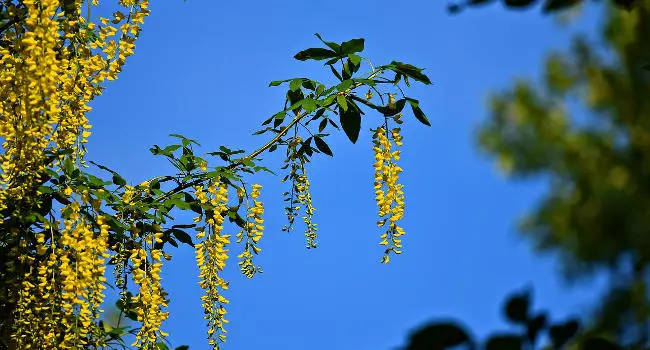

Scientific Name: Laburnum anagyroides
Level of Toxicity to Dogs: Mild to Moderate
Common Symptoms to Watch For: Vomiting, Weakness, Staggering, Diarrhea, Dilated pupils
The Golden chain tree also called golden rain tree is a tree like plant that produces a chain of flowering vines. The plant contains lupine alkaloids that are found all over the tree including the seeds. lupine alkaloids can be extremely dangerous if consumed in heavy amounts. Symptoms can show in as little as an hour. The seedpods of the plant is the most toxic part of the golden chain tree because the toxins are more concentrated in that area. A dog that consumes any part of the plant especially the seedpods will require immediate medical attention and should not be taken lightly as it could be fatal.
Heavenly Bamboo
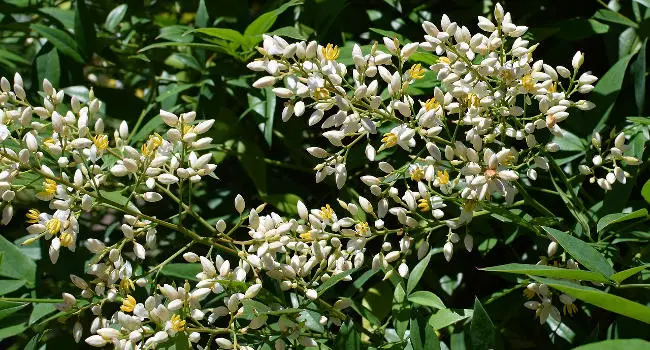

Scientific Name: Nandina domestica
Level of Toxicity to Dogs: Severe
Common Symptoms to Watch For: Vomiting, Abdominal Pain, Increased Heart Rate, Respiratory failure, Shock
The heavenly bamboo also known as nandina are attractive plants that's usually found on gardens, parks and yards. The plant is toxic to dogs and small animals because of its defensive mechanism that contains cyanide. The leaves, stems and the most toxic part of the plant its berries if consumed by dogs depending on how many they eaten could be life threatening. Be aware of this type of plants during walks as some dogs tend to eat the berries of the plant because of how delicious it looks.
Hellebore (aka Christmas Rose)
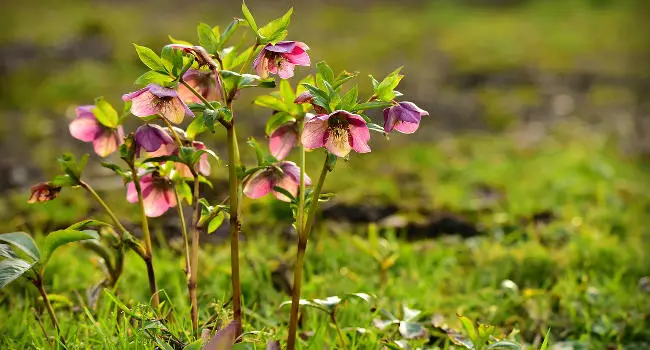

Scientific Name: Helleborus
Level of Toxicity to Dogs: Mild to Moderate
Common Symptoms to Watch For: Diarrhea, Anemia, Lethargy, Seizures, Shaking
The Christmas Rose is a beautiful plant that are usually on display during winter season on homes but these plants are highly toxic to dogs. The plant contains glycosides that are toxic to dogs. Poisoning will happen if a dog eats or swallowed any part of the plant from roots to the stems. Although a small amount of ingestion is not serious a big amount of it can be life threatening.
Hydrangea
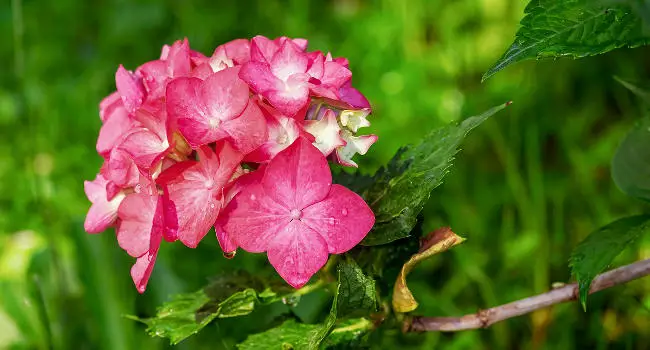

Scientific Name: Hydrangea
Level of Toxicity to Dogs: Mild
Common Symptoms to Watch For: Vomiting, Diarrhea, Lethargy
The Hydrangea is an attractive plant with colorful flowers that gardener's love to plant in their gardens. This plant has the ability to change color depending in the soil that it's in. Although the plant is great to have in the garden it is quite toxic to dogs and cats as it contains cyanogenic glycosides. A dog that consumes the buds and the leaves will get poisoned by this plant and depending on how much they have consumed could pose a serious problem in their health.
Iris


Scientific Name: Iris germanica
Level of Toxicity to Dogs: Mild to Moderate
Common Symptoms to Watch For: Vomiting, Diarrhea, Lethargy, Drooling
The Iris plant is adored by many gardeners and usually found in many homes because of its fragrance and beauty. The plant though is quite toxic to dogs due to an abundance of resinous purgative irisin and cytotoxic terpenoids. These toxins are found all over the plant and should not be taken lightly if you have these at your home as dogs tend to chew or eat the plant.
Jerusalem Cherry
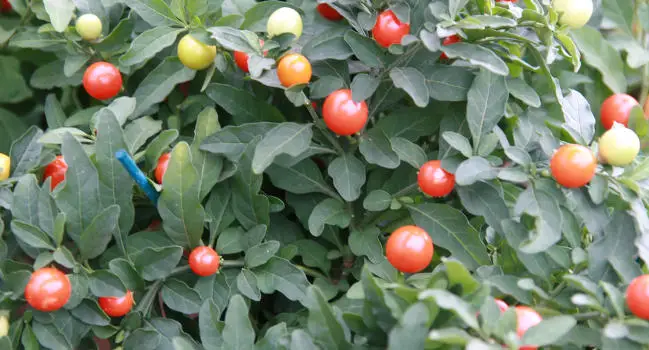

Scientific Name: Solanum pseudocapsicum
Level of Toxicity to Dogs: Mild to Moderate
Common Symptoms to Watch For: Vomiting, Diarrhea, Seizures, Drooling, Ulceration
The Jerusalem cherry also known as Winter cherry are common during Christmas time and has a beautiful red or yellow berries. The plant can be quite toxic to dogs as cases also shows that it could be fatal. Every part of the winter cherry is toxic to dogs especially the berries as the poison is more concentrated. Poisoning is due to consumption or ingesting the plant and usually dogs tend to eat the berries of the plant and small dogs are more at risk with this plant.
Jessamine (aka Carolina Jessamine, Yellow Jessamine)
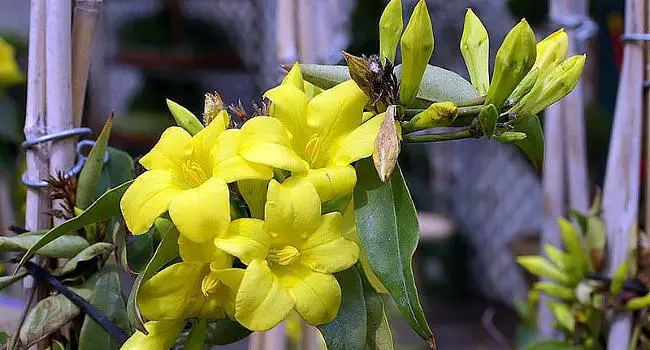

Scientific Name: Gelsemium sempervirens
Level of Toxicity to Dogs: Moderate
Common Symptoms to Watch For: Muscle weakness, Paralysis, Difficulty swallowing, Vision problems, Seizures
The Jessamine has many names such as; Carolina jessamine, Yellow Jessamine, Evening Trumpet and woodbine. This vine with yellow trumpet like flowers are not only toxic to humans but also to our beloved dogs. They can be found mostly in gardens to cover garden arbors. All parts of the plant are toxic to dogs as they contain neurotoxins such as alkaloids and gelsemine. A lot of dogs who have easy access to their owners gardens love to chew and eat these vines and that is when the toxin get in to their system causing vomiting, weakness and even paralysis. Contact your veterinarian for immediate treatment if you found your dog chewing or eating jessamine’s.
Jimson Weed
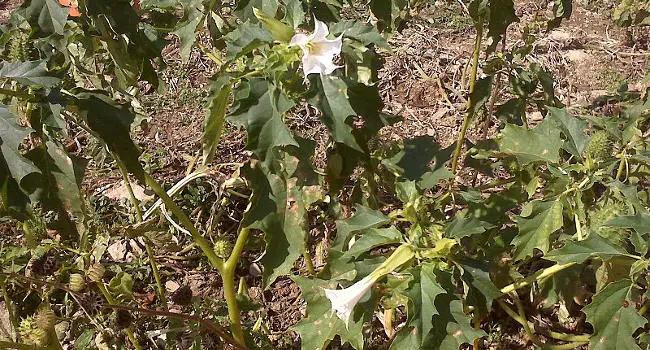

Scientific Name: Datura stramonium
Level of Toxicity to Dogs: Moderate
Common Symptoms to Watch For: Restlessness, Dilated pupils, Dry mouth, Constipation, Staggering
The Jimson weed also called devil's snare, thorn apple or moonflower are usually found in cultivated fields or grazing lands. The plant has a powerful hallucinogenic alkaloids that is highly poisonous to humans and animals. Every part of the jimson weed is considered toxic to dogs but dogs tend to stay away from this plant because of its odor and the leaves are bitter if consumed. But there are some cases a curious dog would try to eat these plants and that is quite dangerous as the poison will damage their digestive system, nerves and muscles. If you see your dog eating this plant remove any plant material on its mouth and rinse with warm water. A visit to the vet for immediate treatment is needed.
Lacy Tree (aka Selloum, Philodendron, Tree Philodendron)
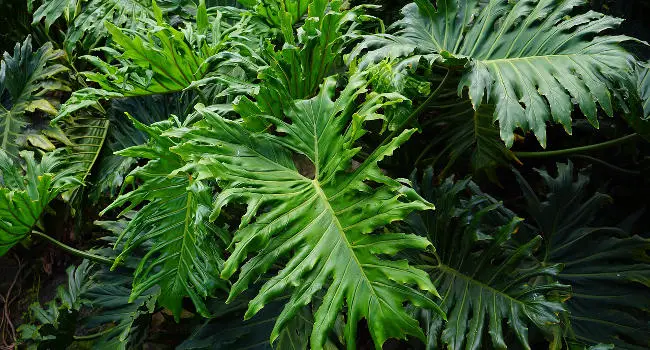

Scientific Name: Philodendron selloum
Level of Toxicity to Dogs: Mild to Moderate
Common Symptoms to Watch For: Drooling, Pawing at the mouth, Oral pain, Vomiting, Decreased appetite
A small tree and usually found in a tropical environment the Lacy tree has a unique set of leaves and can grow to 5 ft. in length. The lacy tree also known as Selloum are very toxic to dogs due to it having calcium oxalate crystal present. Dogs who consumes or eats any part of the plant is life threatening because of the toxins found in the plant and there is also a chance a dog can have an allergic reaction to the saps of the lacy tree. Symptoms of poisoning is immediate and dogs deter from eating the plant but in some cases they are not dissuade from eating it. An immediate medical attention is required if you see your dog eating any part of the lacy tree.
Lantana


Scientific Name: Lantana
Level of Toxicity to Dogs: Mild to Moderate
Common Symptoms to Watch For: Vomiting, Bloody Diarrhea, Frequent urination, Depression, Liver failure
The Lantana also known as red sage or wild sage are beautiful flowering plants that may have a variety of colors such as red, yellow, white or even blue. These plants are usually found in the wild and when going for hikes or walks with your dog keep an eye out for these plants as they are toxic and the berries that it produces where the poison is mostly concentrated could be fatal. A dog will be poisoned by these plants by eating or consuming any part of the plant. Symptoms can be seen usually within 24 hours of consumption and more serious complications takes several days.
Larkspur


Scientific Name: Delphinium
Level of Toxicity to Dogs: Mild to Moderate
Common Symptoms to Watch For: Drooling, Constipation, Paralysis, Seizures, Abdominal pain
The Larkspur also known as Delphinium is an attractive plant that have many different types and can grow to over 6 ft. These plants are not only poisonous to dogs but to humans as well as it contains a toxin called diterpene alkaloids. Eating and ingesting the said plant is the only way a dog can be poisoned by the larkspur. Contact immediately or go to your nearest animal hospital if you see your dog eating on the plant.
Leeks
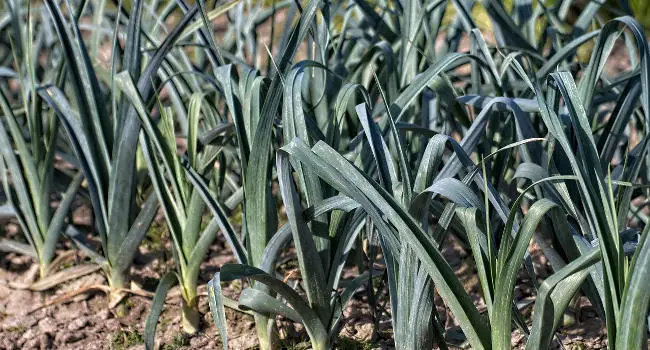

Scientific Name: Allium ampeloprasum
Level of Toxicity to Dogs: Mild to Moderate
Common Symptoms to Watch For: Drooling, Nausea, Vomiting, Diarrhea, Lethargy, Abdominal pain
Leek plants also known as chives or garlic are vegetables that are usually found daily in our food. It doesn't mean that if it's safe for us to eat it will be with dog's. The leek contains a compound called organosulfate that is poisonous to dogs and also to cats. There also cases that these vegetables can be more dangerous to certain breeds such as Japanese dogs. We sometimes feed our dogs our meal that contains this vegetable and they could suffer poisoning of their blood as the poison attacks the red blood cells and may lead to organ damage. Symptoms of poisoning usually depends on how much a dog consumes and may take several days before it becomes apparent.
Lily of the Valley
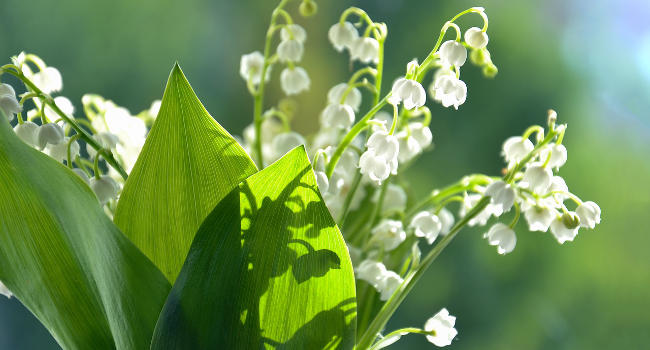

Scientific Name: Convallaria majalis
Level of Toxicity to Dogs: Severe
Common Symptoms to Watch For: Vomiting, Diarrhea, Slowed heart rate, Severe heart arrhythmias, Seizures
A perennial flowering plant the Lily of the valley has bell shaped flowers and fruits and are usually abundant during late spring and summer. These plants should be treated with caution especially around with dogs as like most lilies they can be fatal because of the saponins and glycosides present on the plant. Any part of the plant if consumed by dogs could poison them symptoms could show in a matter of hours. Treatment should be given right away if you see your dog eating these plants.
Marigold


Scientific Name: Tagetes
Level of Toxicity to Dogs: Mild to Moderate
Common Symptoms to Watch For: Drooling, Vomiting, Diarrhea, Skin irritation
The Marigold are plants found usually in the gardens because of its beautiful colors such as red, orange and yellow that brightens up the garden. There are several variety of marigold and some of them are mildly toxic and others like the marigold calendula are non-toxic. Ingestion or consuming the plant can cause vomiting and diarrhea as some dogs tend to eat a large amount of these plants. Although poisoning could be mild it is still best to visit your veterinarian for some help if you see your dog eating these plants.
Morning Glory


Scientific Name: Ipomoea
Level of Toxicity to Dogs: Mild to Moderate
Common Symptoms to Watch For: Vomiting, Diarrhea, Incoordination
A beautiful vine that has a trumpet like flowers is the morning glory. These plants just as the name suggest open up in the morning and thrive on sunlight. Morning glories are toxic to dogs but only the Ipomoea violacea or pink morning glory. Dogs can be poisoned by eating the seeds of the plant and depending of the amount they ate could also mean how much poison they will have on their system. Immediate treatment is required by bringing the dog to a veterinarian as soon as possible as a variety of symptoms can occur such as diarrhea, liver failure vomiting and more.
Oleander


Scientific Name: Nerium oleander
Level of Toxicity to Dogs: Severe
Common Symptoms to Watch For: Drooling, Nausea, Vomiting, Abnormal heart rate, Cardiac arrhythmias
These plants are toxic to both humans and dogs. Every part of the oleander plant is a danger to our dogs especially the stems and roots as it contains most of the toxin. Even a standing water that may have leaves of this plant will be toxic if ingested. Symptoms of oleander poisoning are drooling, nausea, vomiting, diarrhea, abdominal pain, drowsiness, dilated pupils, lack of coordination, inability to rise, lethargy, weakness and abnormal heart rate.
Peace Lily
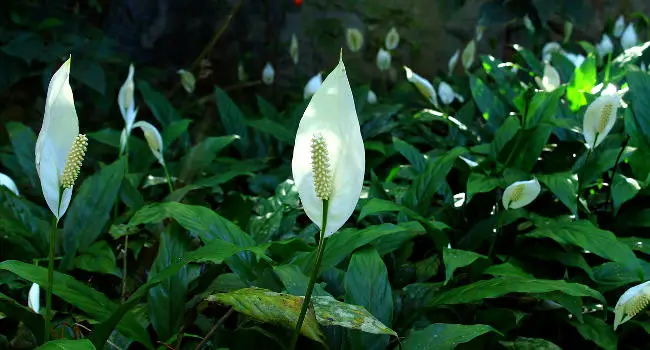

Scientific Name: Spathiphyllum
Level of Toxicity to Dogs: Mild to Moderate
Common Symptoms to Watch For: Drooling, Pawing at the mouth, Oral pain, Decreased appetite, Vomiting
The Peace lily plant are beautiful plants that's usually found in homes and gardens. The plant like most of the araceae family are toxic to dogs and even human's if ingested. It contains a poisonous content insoluble calcium oxalate crystals that are present on any part of the plant. The toxin cause intense pain and swelling of the mouth making dogs having a hard time to breathe. Dogs tend to stay away or deter from eating this plant in large amounts as the symptoms comes almost instant but there are some dogs will try to consume this plant and that is a cause for concern. If you see a your dog chewing or eating this plant immediately try to rinse their mouth with fresh clean water to remove much of the toxin as possible and a visit to your vet as soon as possible if a dog has ingested any part of the plant.
Peony


Scientific Name: Paeonia
Level of Toxicity to Dogs: Mild to Moderate
Common Symptoms to Watch For: Vomiting, Diarrhea
A beautiful plant that most gardening enthusiast love to put in their garden as it brings out vibrant colors to the garden is the Peony. The plant is quite toxic to animals and that means dogs who love to play in the garden are at risk. Peonies contain paeonol that is toxic to dogs and is found all over the plant. Eating and ingesting the plant is the reason a dog will be poisoned as these plants causes gastrointestinal distress depending on how large the amount a dog has consumed.
Periwinkle
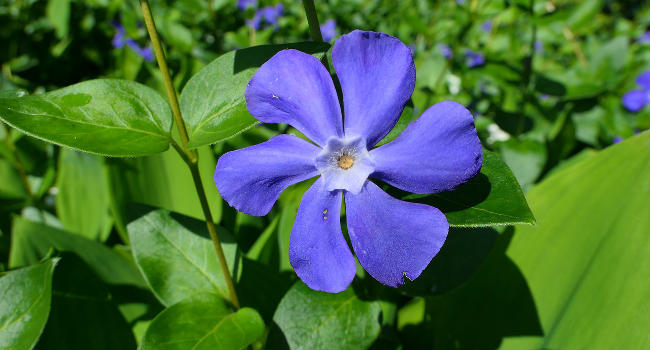

Scientific Name: Catharanthus roseus
Level of Toxicity to Dogs: Mild to Moderate
Common Symptoms to Watch For: Depression, Hypotension, Incoordination, Tremors, Seizures
Periwinkle also known as running myrtle are usually found in the gardens or use as a decorative houseplant. The plant is poisonous to dogs because of vinca alkaloids present in any part of the plant. Ingesting or consuming just a part of the plant can cause a dog to be sick and drop their blood pressure. Some other symptoms if severe can cause seizures and tremors. If you find your dog having these kind of symptoms after eating the periwinkle an immediate medical attention is required.
Poinciana


Scientific Name: Delonix regia
Level of Toxicity to Dogs: Mild to Moderate
Common Symptoms to Watch For: Drooling, Pawing at the mouth, Vomiting, Difficulty swallowing, Diarrhea, Incoordination
A Flowering tree usually thrive on warm climates the Poinciana also known as Barbados pride, peacock flower and bird of paradise. The poiciana can cause mild to moderate toxicity if chewed or consumed. Dogs are not usually drawn to the plant but there are some cases dogs tend to eat the flower bark, leaves and seapods of the plant which causes the poisoning.
Queensland Nut (aka Macadamia Nut)
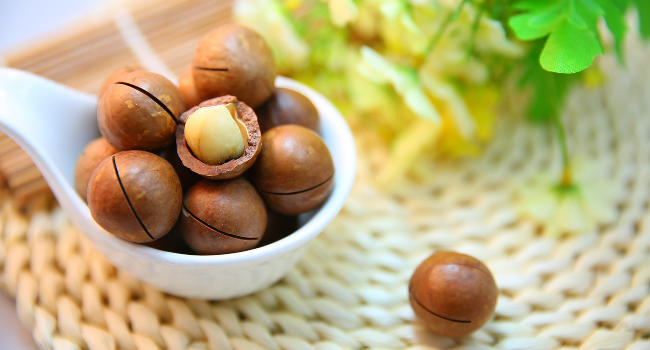

Scientific Name: Macadamia
Level of Toxicity to Dogs: Mild to Moderate
Common Symptoms to Watch For: Lethargy, Hind limb weakness, Joint stiffness, Tremors, Vomiting
The Queensland nut also known as macadamia nuts are usually used to make cookies, candies and other treats. These nuts are said to be poisonous to dogs depending on the amounts consumed but it is considered to be nonfatal. Poisoning could cause vomiting, fevers and tremors to dogs.
Rhododendrons
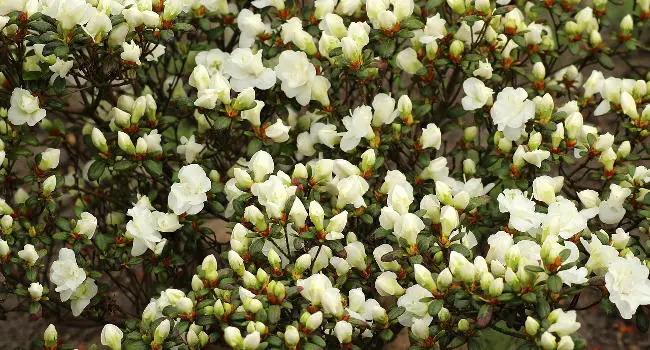

Scientific Name: Rhododendron ferrugineum
Level of Toxicity to Dogs: Severe
Common Symptoms to Watch For: Drooling, Vomiting, Diarrhea, Abnormal heart rate, Seizures, Coma
The Rhododendrons are flowering plants that is well known in the history as it produces a poisonous honey that is toxic to us humans. Dogs are less likely to be poisoned by the honey but the leaves and flowers of the rhododendrons can cause serious problems. There are many different species of rhododendrons and some of them are used as garden ornamentals. To be safe we should assume all species are quite poisonous to dogs. Dogs can be very curious at times and will eat the leaves and flowers of the plant if these happens contact your veterinarian as soon as possible, they would require an immediate medical attention.
Rhubarb
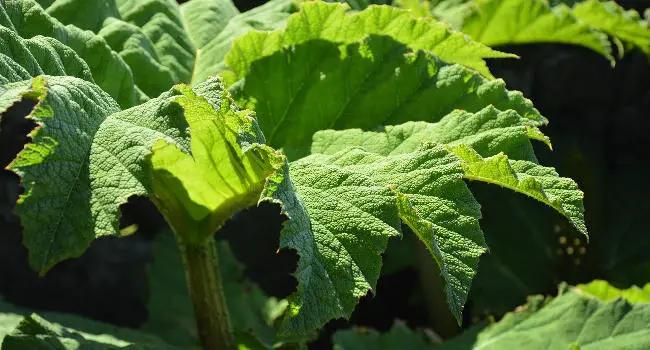

Scientific Name: Rheum rhabarbarum
Level of Toxicity to Dogs: Mild to Moderate
Common Symptoms to Watch For: Drooling, Decreased appetite, Vomiting, Diarrhea, Lethargy, Weakness, Tremors, Bloody urine
The rhubarb plant also goes by the name of pie plants are usually seen at backyards. These plants have calcium oxalate crystals that are concentrated more on the large leaves. Dog's and other animals deter from eating the plant as it gives a foul taste and when chewed causes intense pain in their mouth. In some cases dogs would ingest the plant and it causes serious problems as the toxin will cause symptoms like diarrhea, excessive drooling and even coma. If you see your dog chewing on the plant try rinse their mouth with cool water and remove as much plant material in their mouth if possible. A visit to the veterinarian is a must if the dog has ingested the plants leaves.
Ribbon Plant (aka Lucky Bamboo)


Scientific Name: Dracaena sanderiana
Level of Toxicity to Dogs: Mild to Moderate
Common Symptoms to Watch For: Vomiting, Drooling, Diarrhea, Abdominal pain, Weakness, Staggering
Ribbon plant also called as lucky bamboo are evergreen like plants that thrive in warmer climates and is quite a popular houseplant. The plant contains saponins that are found all over the plant causing dogs who eats’ any part of the plant get poisoned. Although poisoning could be mild to moderate it is still best to contact your veterinarian to make sure of the dog's condition.
Sago Palm
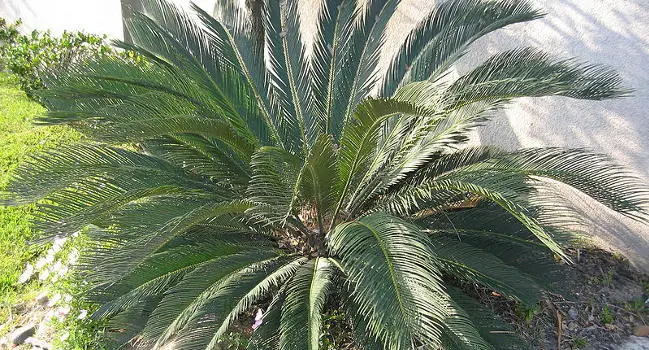

Scientific Name: Cycas revoluta
Level of Toxicity to Dogs: Severe
Common Symptoms to Watch For: Vomiting, Diarrhea, Lethargy, Abdominal pain, Jaundice, Black-tarry stool
The sago palm also known as coontie palms, cardboard palms, cycads, or zymias. These plants are toxic to dogs if ingested especially the leaves as it has a toxin called cycasin. This toxin can cause liver damage to our dogs and potentially the cause of their death. Symptoms includes vomiting, blood in feces, bloody diarrhea, yellow coloration of skin and gums, increased thirst, increased urine, bruising, bleeding easily, depression, circling paralysis, seizures, and coma.
Schefflera (aka Dwarf Umbrella Tree)
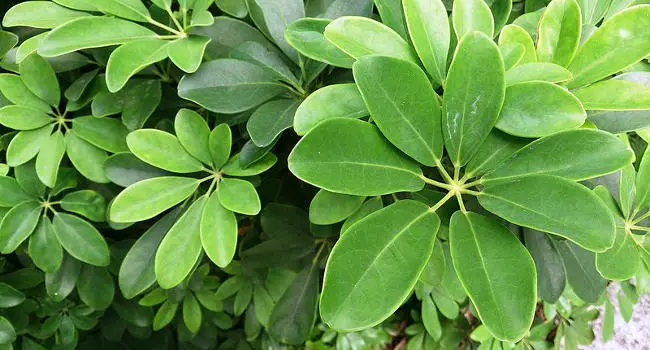

Scientific Name: Schefflera arboricola
Level of Toxicity to Dogs: Mild to Moderate
Common Symptoms to Watch For: Drooling, Pawing at the mouth, Oral pain, Decreased appetite, Vomiting
Schefflera commonly known as umbrella tree or octopus tree are small tree's that have 12 glossy green leaves from each branch. Similar with the araceae family of plants these plants contain insoluble calcium oxalate that could cause health problems to dogs. Chewing or eating any part of the plant will cause irritation and pain in the dogs mouth and if ingested causes swelling in the throat making difficulty breathing. If you see your dog chews or eats any part of the plant try to remove any part left in their mouth and offer the dog cold water to drink to ease the pain.
Tobacco Plant
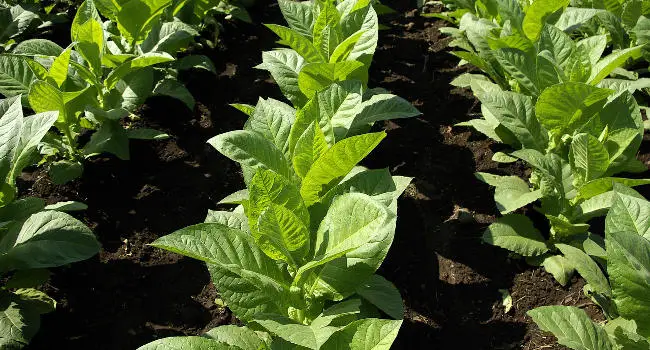

Scientific Name: Nicotiana tabacum
Level of Toxicity to Dogs: Severe
Common Symptoms to Watch For: Vomiting, Abnormal heart rate, Agitation, Tremors, Seizures
Tobacco plants are beautiful shrubs that's usually find in the wild and these plants aren't a good to be garden plants if you have dogs around. The plant is quite toxic to dogs as it contains several poisonous substance such as nicotine, germacrene and anabasine. These toxins could be proven lethal to dogs and common side effects are paralysis, abnormal heart rates, pupil dilation, vomiting and more. These requires immediate medical attention if a dog has ingested or consumed these plants.
Tomato Plant
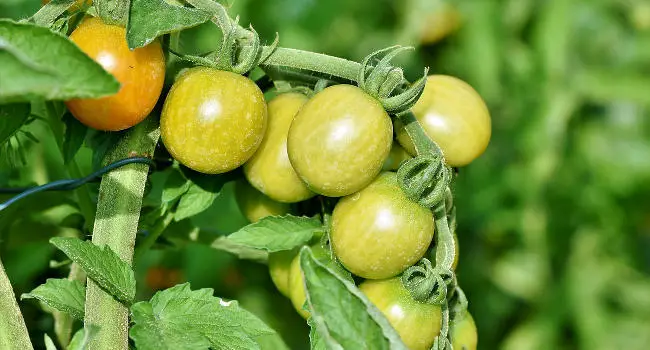

Scientific Name: Solanum lycopersicum
Level of Toxicity to Dogs: Mild to Moderate
Common Symptoms to Watch For: Vomiting, Diarrhea, Lethargy, Weakness, Confusion
Tomato plants are quite common during summer time and these commonly eaten ripened tomato fruit is considered non-toxic to dogs. But, if a dog consumes the green part of a tomato plant this could lead to tomatine poisoning. Symptoms include gastrointestinal upset, cardiac effects, loss of coordination, muscle weakness, tremors, and seizures.
Tulips & Hyacinths


Scientific Name: Tulip
Level of Toxicity to Dogs: Mild to Moderate
Common Symptoms to Watch For: Drooling, Nausea, Vomiting, Diarrhea, Difficulty breathing
A popular flower that will brighten our day but harmful to our dogs are tulips. These plants contain glycosides, if ingested by dogs can be fatal. Symptoms of tulip poisoning are abdominal pain, cardiac arrhythmias, coma, depression, diarrhea, difficulty breathing, dizziness, excessive drooling, lethargy, seizures, tremors and vomiting. Contact your veterinarian immediately if a dog ingested the tulip.
Yesterday, Today and Tomorrow


Scientific Name: Brunfelsia pauciflora
Level of Toxicity to Dogs: Severe
Common Symptoms to Watch For: Vomiting, Anxiety, Difficulty walking, Staggering, Tremors, Seizures
The plant yesterday, today and tomorrow are flowering shrubs that's gotten its name from the way it changes colors from purple to white in just several days. These plants are one of the common plants that causes dog poisoning, the berries of the plant are quite tempting for dogs to eat. Every part of the plant is poisonous to dogs as it contains 3 different toxins that if not treated quickly could result to serious health problems and even death. One of the reason this plant is dangerous because the symptoms of poisoning will not be visible for several hours until the poison has already been all over their system. This requires immediate medical attention if you see you’re dog eating these plants.
List of House Plants That Are Poisonous to Dogs
African Evergreen (aka Arrowhead Vine)
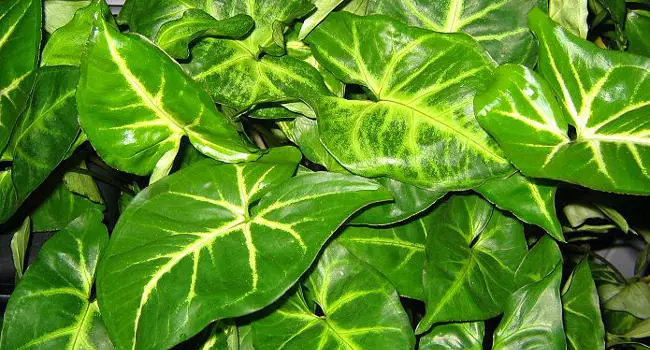

Scientific Name: Syngonium podophyllum
Level of Toxicity to Dogs: Mild to Moderate
Common Symptoms to Watch For: Drooling, Vomiting, Pawing at the mouth, Oral pain, Decrease in appetite
The Arrowhead vine has many names such as african evergreen, american evergreen, goosefoot plant, nephthytis and trileaf wonder. These plants contains calcium oxalate crystals like the anthurium plant. The toxin is found in every part of the plant so if a dog tries to chew any part of the plant they will suffer irritation and swelling of the mouth. When a part of the plant is ingested the toxin will cause gastrointestinal tract.
Aloe Vera
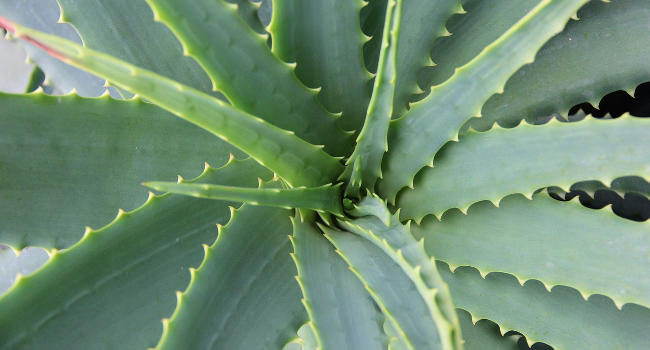

Scientific Name: Aloe vera
Level of Toxicity to Dogs: Mild to Moderate
Common Symptoms to Watch For: Vomiting, Diarrhea, Depression, Anorexia, Changes in urine color
The aloe vera plants which is a common houseplant has many medicinal value to us humans and dogs alike. Be aware though as Aloe contains anthraquinone glycosides, if ingested can cause vomiting, diarrhea, anorexia, and rarely tremors.
Anthurium (aka Flamingo Plant)



Scientific Name: Anthurium andraeanum
Level of Toxicity to Dogs: Mild to Moderate
Common Symptoms to Watch For: Drooling, Pawing at the face or mouth, Oral pain, Decrease in appetite, Vomiting
The Flamingo plant is a gorgeous looking plant that are popular with gardeners and use in homes as it doesn't require much sun to thrive. The plant is extremely toxic to dogs and cats as it contains insoluble calcium oxalate. The toxins are found in any part of the plant and dogs that chews or eats the plant will suffer intense pain in their mouth and if intgested could cause difficulty in breathing as swelling of the oral area would block air. Symptoms will occur immediately and if a dog have ingested this toxic plant contact your veterinarian ASAP.
Asparagus Fern (aka Emerald Fern)



Scientific Name: Asparagus densiflorus
Level of Toxicity to Dogs: Mild
Common Symptoms to Watch For: Vomiting, Diarrhea, Abdominal pain, Skin irritation
The Asparagus Fern also known as emerald fern or emerald feather is a house plant and also can be found in the gardens. The toxin found in these plants are called sapogenin which are found in the berries. The berries if swallowed or ingested by dogs can cause gastrointestinal distress, vomiting and diarrhea. The sap of the plant can cause the dog's skin to have blistering, redness and swelling.
Baby’s Breath
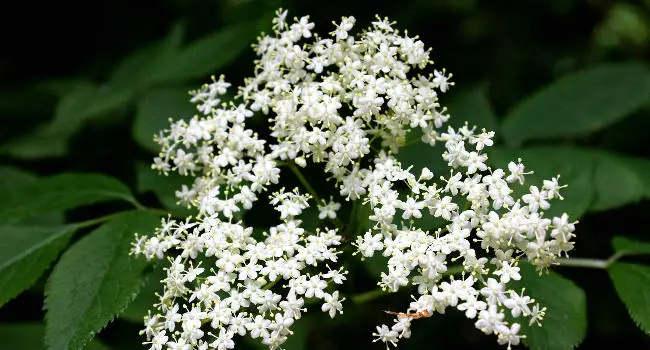

Scientific Name: Gypsophila
Level of Toxicity to Dogs: Mild to Moderate
Common Symptoms to Watch For: Vomiting, Diarrhea, Anorexia, Lethargy, Depression
These flowers are commonly found in the garden and are mildy toxic to dogs. The toxins come from the flowers and leaves of the baby's breath if ingested. Symptoms of these plants are vomiting, diarrhea, weight loss, lethargy and depression.
Bird of Paradise


Scientific Name: Strelitzia
Level of Toxicity to Dogs: Severe
Common Symptoms to Watch For: Vomiting, Drowsiness, Rapid pulse, Muscle Tremors
The Bird of Paradise plant is a tall and gorgeous looking plant that is usually found in gardens. These plants has a toxic component called hydrocyanic acid. The plants parts and especially the fruit of the plant are highly toxic to dogs if ingested. Symptoms of toxicity may appear as early as 20 minutes such as vomiting and diarrhea. It is recommended that if you found your dog chewing or eating the plant, you need to take them to your local veterinarian immediately.
Charming Dieffenbachia
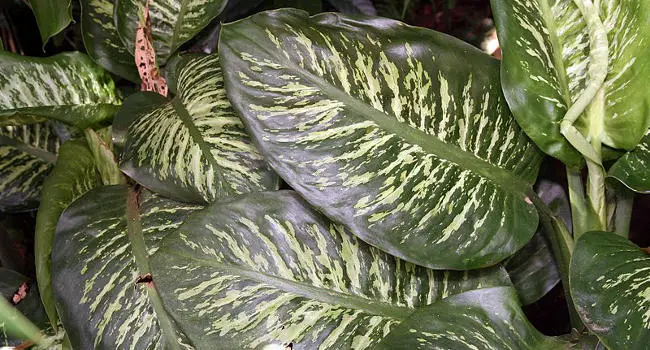

Scientific Name: Dieffenbachia amoena
Level of Toxicity to Dogs: Mild to Moderate
Common Symptoms to Watch For: Drooling, Oral pain, Pawing at the mouth, Vomiting, Decreased appetite
The Charming Dieffenbachia also known as dumb cane and tropic snow is a tropical plant commonly seen in homes and gardens. The plant contain just like its araceae family insoluble calcium oxalate crystals that can cause intense pain and irritation in a dog’s mouth if chewed. A dog that has consumed or ingested any part of the plant can also suffer gastrointestinal tract and should visit a veterinarian or a animal hospital immediately.
Crown of Thorns
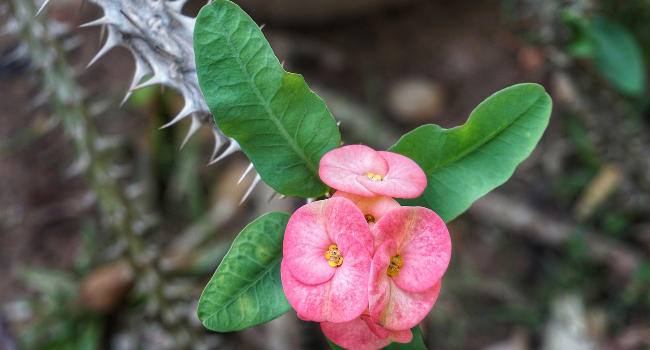

Scientific Name: Euphorbia milii
Level of Toxicity to Dogs: Mild to Moderate
Common Symptoms to Watch For: Drooling, Vomiting, Diarrhea, Skin irritation, Eye irritation
The Crown of Thorns also known as Christ thorn or Christ plant is a cactus like plant that are usually found in homes and gardens. A dog usually stays away from the Christ plant as it has thorns that could injure them and cause irritation to their skin. There are dogs who like to dig into the garden and a possibility that they may eat the plant then that is where the poison comes especially eating the white sap of the plant. One of the common symptoms of ingesting the plant is vomiting and sometimes with blood, when this happens contact your veterinarian immediately for treatment.
Dracaena (aka Corn Plant, Striped Dracaena, Warneckii Dracaena)


Scientific Name: Dracaena fragrans
Level of Toxicity to Dogs: Mild to Moderate
Common Symptoms to Watch For: Drooling, Vomiting, Diarrhea, Abdominal pain, Weakness, Staggering
The Corn Plant also known as the Cornstalk Plant is a common household plant is toxic to both cats and dogs. The plant contains Saponin that is a toxic chemical compound and alkaloids. This indoor plant can cause mild to moderate poisoning if ingested by dogs and causes gastrointestinal upset like vomiting and diarrhea.
Dragon Tree


Scientific Name: Dracaena draco
Level of Toxicity to Dogs: Mild to Moderate
Common Symptoms to Watch For: Drooling, Vomiting, Diarrhea, Abdominal pain, Weakness, Staggering
The Dragon tree also known as Madagascar Dragon tree is a plant usually found in homes and offices. The plant contains a toxin called steroidal saponins which are found in the entire plant. A dog can be poisoned from chewing or eating any part of the plant and symptoms of poisoning may depend on the amount ingested from the plant. Contact your veterinarian immediately if you found your dog chewing or eating the dragon tree.
Fiddle-Leaf Philodendron (aka Heartleaf Philodendron, Horsehead Philodendron)
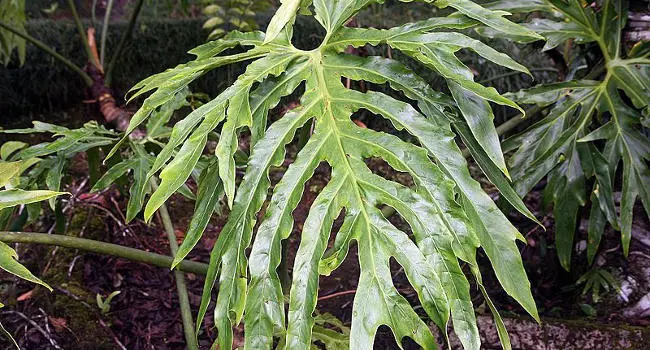

Scientific Name: Philodendron
Level of Toxicity to Dogs: Mild to Moderate
Common Symptoms to Watch For: Drooling, Pawing at the mouth, Oral pain, Decreased appetite, Vomiting
The Fiddle leaf plant also known as cordatum, panda plant or saddle leaf is a popular houseplant and also found in gardens. This plant contains calcium oxalate crystals which is present all over the plant. The oxalate crystals presents a danger to dogs as this crystals if ingested can cause intense pain to the dog’s mouth, lips and tongue. The pain from their tongue can make their breathing difficult and will reach to dangerous levels. It does not only stop there if the dogs eyes and skin are exposed they will suffer irritation as well.
Giant Dumbcane
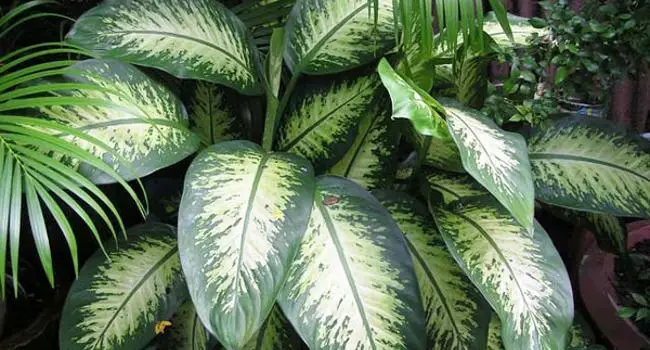

Scientific Name: Diffenbachia amoena
Level of Toxicity to Dogs: Mild to Moderate
Common Symptoms to Watch For: Drooling, Pawing at the mouth, Oral pain, Decreased appetite, Vomiting
The Giant dumbcane are plants we usually see at homes because of its giant spotted leaves that looks great in any part of the house. These plants do not go well with dogs as it contains insoluble calcium oxalate that when chewed or ingested by dogs could cause intense pain in their mouth and eating large amounts could cause swelling in their throat causing difficulty in breathing. If you see your dog eat any part of the dumbcane try to remove any plant material in its mouth and provide them with cold water to relieve the pain. Contact immediately your veterinarian for immediate medical assistance if they have ingested the plant as it could cause further health problems such as kidney issues.
Golden Pothos (aka Devil's Ivy, Hunter's Robe, Marble Queen)
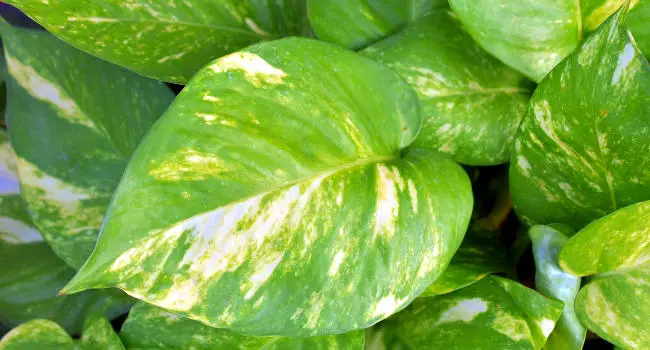

Scientific Name: Epipremnum aureum
Level of Toxicity to Dogs: Mild to Moderate
Common Symptoms to Watch For: Drooling, Pawing at the mouth, Oral pain, Decreased appetite, Vomiting
The Golden Photos also called as Devil's Ivy is what they call a green climbing plant that usually found in the garden. The plant contain a toxin called insoluble calcium oxalate as it is part of the Araceae family of plants. The toxin can be found all over the plant and just by chewing the plant can cause intense irritation and pain to the mouth. Ingestion or eating any part of the plant even the leaves can cause choking due to swelling of the mouth. Usually a dog would be deterred from continuing on eating the plant as the symptom is immediate.
Hurricane Plant (aka Split-Leaf Philodendron, Mexican Breadfruit)
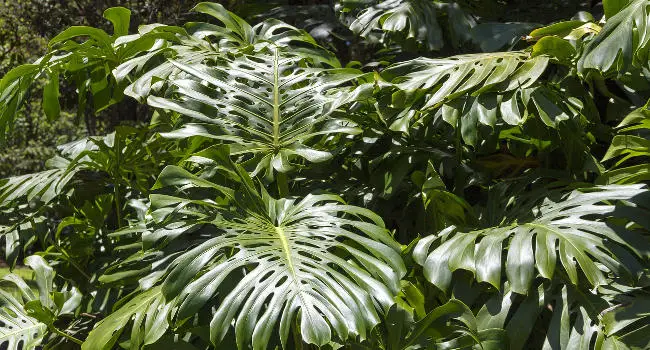

Scientific Name: Monstera deliciosa
Level of Toxicity to Dogs: Mild to Moderate
Common Symptoms to Watch For: Drooling, Pawing at the mouth, Oral pain, Decreased appetite, Vomiting
One of the plants that are quite common in people’s homes are Hurricane plants also known as Swiss cheese plant or Mexican breadfruit plants. These plants are toxic to dogs because it contains insoluble calcium oxalates. The toxin is found all over the plant and dogs usually would try to take a bite or chew on the leaves of this plant. Symptoms are immediate such as irritation and intense pain in the mouth. Consuming or ingesting any part of the plant causes serious problems as they could suffer from difficulty of breathing due to the swelling in their upper airway and will have problem swallowing food. If you see your dog eating the hurricane plant try to remove all the plant materials in its mouth and provide the dog some cold water to drink to slightly relieve the pain. Contact your veterinarian as soon as possible to further check on their condition.
Kaffir lily


Scientific Name: Clivia miniata
Level of Toxicity to Dogs: Mild to Moderate
Common Symptoms to Watch For: Drooling, Vomiting, Diarrhea, Hypotension, Tremors, Cardiac rhythm abnormalities
A tropical plant that has been growing in popularity in homes and gardens because of it's beautiful flowers are Kaffir lilies. These plants are not from the lily family but they can still pose a threat to dogs and cats. The plant contains alkaloids and lycorine that if ingested in large amounts could cause serious problems. These toxins are more concentrated on the bulbs and fruits of the plant and that is what dogs tend to eat. Although the kaffir lily can be considered as mild to moderate poisoning it is still good to check to your veterinarian if you see your dog eating the plant.
Kalanchoe
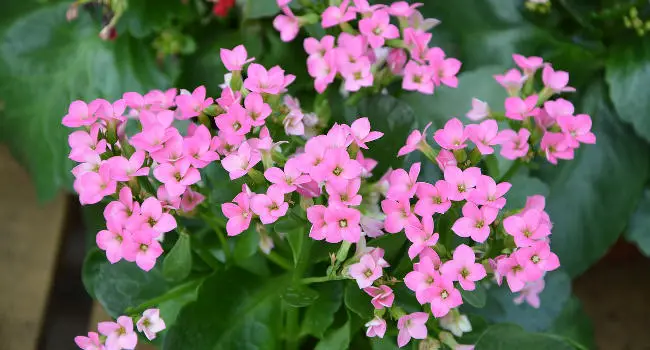

Scientific Name: Kalanchoe
Level of Toxicity to Dogs: Mild to Moderate
Common Symptoms to Watch For: Drooling, Vomiting, Diarrhea
Kalanchoe is a common houseplant that is adored by many because of its beauty and wide range of colorful flowers it produces. The kalanchoe contains cardiac glycosides which is poisonous to dogs and if not treated right away could cause serious health problems and even death. Every part of the kalanchoe plant is toxic to dogs even the water inside the vase where you put the plant is toxic to dogs. It is best if you have these plants in your home to keep them out of reach from your dogs. The poison not only affects the dogs gastrointestinal system it also affect the dogs nervous system. It is best if you see your dog eating the plant to take them to your nearest animal hospital or veterinarian as they require immediate medical attention.
Mother-in-Law’s Tongue (aka Sansevieria)


Scientific Name: Sansevieria trifasciata
Level of Toxicity to Dogs: Mild to Moderate
Common Symptoms to Watch For: Drooling, Decreased appetite, Vomiting, Depression
The Mother-in-Law's Tongue also called as the good luck plant, golden bird's nest or snake plant are plants that are commonly seen in homes and offices. These plants are poisonous to dogs when ingested because of the saponins found in the plants leaves and flowers. Although poisoning could be mild to moderate depending on the amount consumed such as drooling, vomiting and diarrhea. It is still best to contact your veterinarian immediately to further check on the dog's condition.
Poinsettia


Scientific Name: Euphorbia pulcherrima
Level of Toxicity to Dogs: Mild to Moderate
Common Symptoms to Watch For: Drooling, Licking lips, Vomiting, Diarrhea, Skin irritation (including redness, swelling and itchiness) Eye irritation
A very popular plant during the holiday's the Poinsettia plant is a beautiful red flowering plant that's being used as decors in homes during Christmas. The plant has many names such as; euphorbia, lobster flower, flame leaf flower, flower of the night, flower of christmas eve and crown of the andes. The poinsettia has been known to be poisonous to dogs but depending on the level of amount consumed it could be mild to moderate poisoning such vomiting, drooling and diarrhea. The milky sap of the plant may cause skin irritation if in contact and eye exposure. Medical treatment are usually not needed unless it is severe.
Rubber Tree Plant
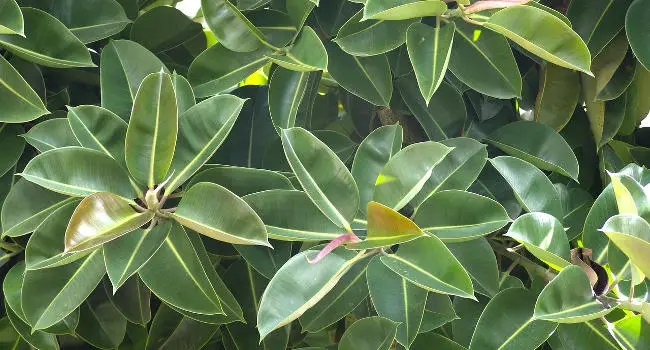

Scientific Name: Rubber Tree Plant
Level of Toxicity to Dogs: Mild to Moderate
Common Symptoms to Watch For: Decreased appetite, Drooling, Vomiting, Diarrhea, Skin Irritation
The Rubber tree plant has a wide variety of plants such as Indian rubber plant, Jade plant and American rubber plant. The Indian and Jade plant are toxic to dogs, whereas the American rubber plant are considered nontoxic. The Indian plant if ingested can cause vomiting, drooling and also can cause irritation of the skin if exposed. The Jade plant or dwarf rubber plant can cause vomiting and depression if consumed or ingested. If you see your dog eating a rubber tree plant consult your veterinarian for further check up on his health.
Weeping Fig (aka Ficus)
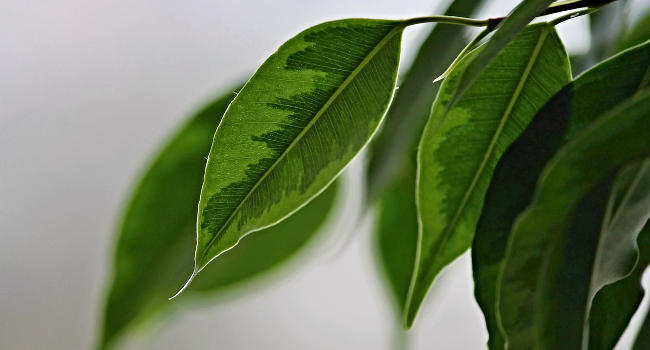

Scientific Name: Ficus benjamina
Level of Toxicity to Dogs: Mild to Moderate
Common Symptoms to Watch For: Decrease appetite, Drooling, Vomiting, Diarrhea, Skin irritation
The Weeping Fig also known as the benjamin fig, benjamin tree and ficus are common houseplants and sometimes can be seen on offices, backyards and gardens. The ficus should always be far from your dog's reach as it is toxic to dogs. The plant contains 2 poisonous substance that are found all over the plant especially the leaves and fruits as these are the usual suspects of how a dog gets poisoned. The leaves and fruits of the plant can be sometimes irresistible to dogs to chew and eat causing serious health problems. The plants sap if in contact to a dog’s skin can cause dermal irritation. Contact or see your veterinarian immediately if you see you’re dog eating any part of the plant to get their treament as soon as possible.
List of Wild Plants That Are Poisonous to Dogs
Alocasia (aka Elephant Ear)
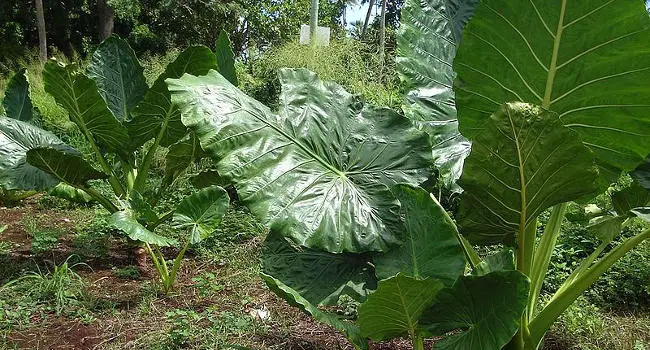

Scientific Name: Alocasia macrorrhizos
Level of Toxicity to Dogs: Mild to Moderate
Common Symptoms to Watch For: Drooling, Pawing at the face or mouth, Oral pain, Decreased appetite, Vomiting
Alocasia also known as the "elephant ear" plant is a common house plant or garden plant. These plants are toxic to dogs and fatal if not treated right away. If a dog eats or ingest any part of an alocasia plant the initial symptom is your dog will have trouble breathing. These plants can also cause skin irritation to dogs when the liquid found inside of the leaves and stems rub through their skin.
American Bittersweet
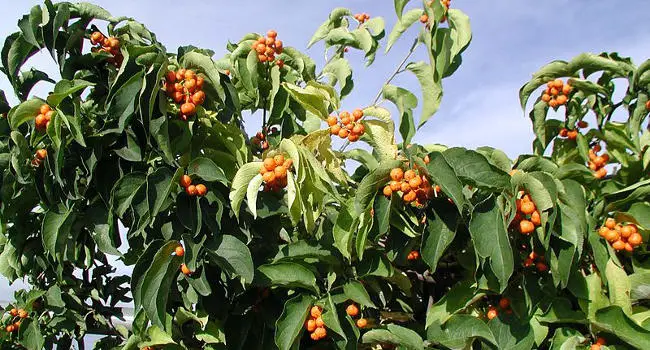

Scientific Name: Celastrus scandens
Level of Toxicity to Dogs: Mild to Moderate
Common Symptoms to Watch For: Diarrhea, Vomiting, Weakness, Seizures
The American Bittersweet has many names such as; bittersweet, false bittersweet, climbing bittersweet, shrubby bittersweet and waxwork are attractive plants that has bright colored fruits that gardeners love to have in their gardens. These plants are toxic to dogs because it contains alkaloids that cause vomiting and diarrhea. One of the main reason a dogs will get poisoned by these plants are the fruits it produces attracting dogs to take a bite. It is not only the fruits of the plant that causes poisoning but any part of the plant if ingested could cause gastrointestinal upset.
Andromeda Japonica
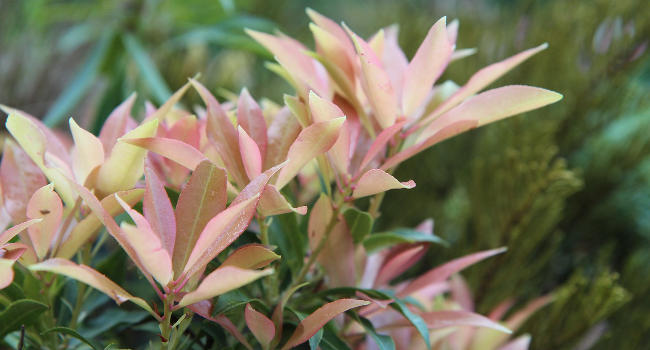

Scientific Name: Pieris Japonica
Level of Toxicity to Dogs: Severe
Common Symptoms to Watch For: Drooling, Depression, Weakness, Vomiting, Diarrhea, Abnormal Heart rhythms
The Andromeda Japonica also known as pieris are beautiful especially when in bloom but they are toxic to dogs. These plants has a toxin called grayanotoxins which are found almost every part of the plant. If you found your dog nibbling the flowers of these plants, try to remove it from their mouth immediately and rush them to your local veterinarian as it is considered a medical emergency.
Autumn Crocus


Scientific Name: Colchicum autumnale
Level of Toxicity to Dogs: Severe
Common Symptoms to Watch For: Drooling, Vomiting, Diarrhea, Inappetence, Black-tarry stool, Organ damage, Respiratory failure, Seizures
The Autumn Crocus also known as meadow saffron or naked lady. These plants contain a poison called colchicine which there is no known antidote. A dog that has eaten any part of the autumn crocus plant can cause severe gastrointestinal distress, multiple damage organ failures and even death. Contact immediately your local veterinarian as it is considered a medical emergency.
Baneberry
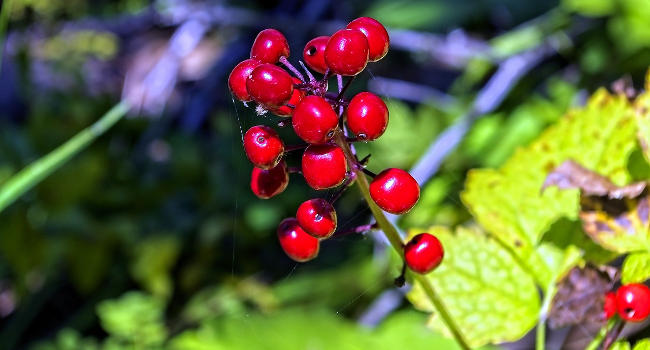

Scientific Name: Actaea
Level of Toxicity to Dogs: Severe
Common Symptoms to Watch For: Blisters, Burning in mouth or throat, Drooling, Vomiting, Diarrhea, Bloody urine
Baneberry are wildflowers and toxic not only to humans but to dogs. Baneberry toxicity is caused by glucoside and ranunculin. These plants if comes to contact with a dog's skin will cause burning and redness. The most dangerous part of the plant are the berries which are very toxic that may cause gastrointestinal tract, vomiting, diarrhea and abdominal pain.
Bear Grass
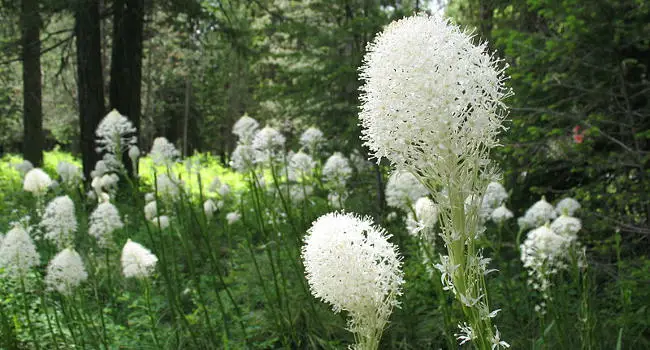

Scientific Name: Xerophyllum tenax
Level of Toxicity to Dogs: Mild to Moderate
Common Symptoms to Watch For: Diarrhea, Vomiting, Decrease in appetite, Swelling of mouth and throat tissue, Abdominal pain, Muscle convulsions
The Bear Grass or xerophyllum tenax are wild plants and are related to lily's. Like all lily related species the bear grass can be toxic to dogs. Although the toxicity is usually mild to dogs and most dogs will have a complete recovery. The possible cause that your dog will be poisoned to bear grass is due to ingesting the plant. Swelling of the mouth, throat, vomiting and diarrhea are the most common symptoms of bear grass poison.
Beech Tree
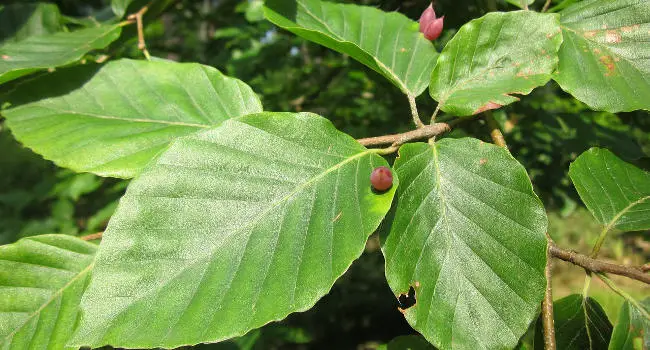

Scientific Name: Fagus
Level of Toxicity to Dogs: Severe
Common Symptoms to Watch For: Dilated Pupils, Vomiting, Diarrhea, Nausea, Fatigue, Severe abdominal pain, Staggering, Collapse, Paralysis, Coma
The Beech tree also are classic tall trees that are usually found around homes. There are 2 known species of beech tree and they are the European and American beech tree both of them are poisonous to dogs but the European is more potent. The 2 species can be differentiated by their leaves. The beech tree also produces the beechnuts which is where the poison is concentrated. Poisoning may occur when a dog eats' the beechnuts or sometimes children will try to feed their dog's with it. Symptoms may vary on the amount a dog consumes and these causes abdominal pain vomiting and diarrhea.
Belladonna (aka Deadly Nightshade)
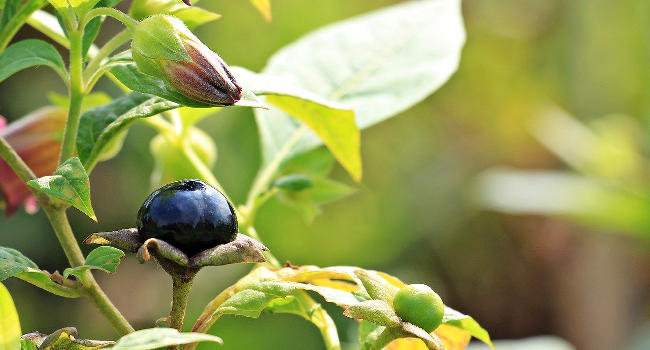

Scientific Name: Atropa belladonna
Level of Toxicity to Dogs: Severe
Common Symptoms to Watch For: Depression, Elevated heart rate, Possible respiratory failure or hallucinations
The Belladonna also known as deadly nightshade is one of the most deadliest toxic plant. These plants contain poisonous alkaloids which are located in every part of the plant. The most lethal part of the plant are the berries and the roots. If ingested by dogs call or go to your nearest veterinarian as soon as possible as it can lead to convulsion, slow heart rate and respiratory failure.
Black Locust
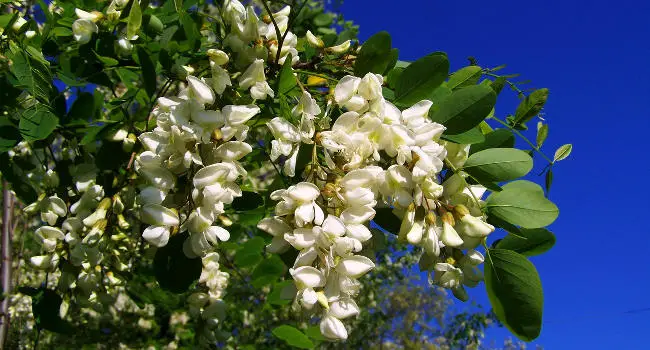

Scientific Name: Robinia pseudoacacia
Level of Toxicity to Dogs: Mild to Moderate
Common Symptoms to Watch For: Diarrhea, Weakness, Depression, Troubling breathing, Kidney or liver damage
The Black Locust is a tree plant and are usually found outdoors or on roadsides. These plants contain a toxin called toxalbumins which is highly toxic to dogs and could result to death of organ systems in the body. Every part of the black locust plant is poisonous if ingested or consumed by dogs. Common symptoms of toxicity when ingested are convulsions and vomiting. So becareful when going for walks along roadsides that has these types of plants that your dog may chew upon.
Bloodroot
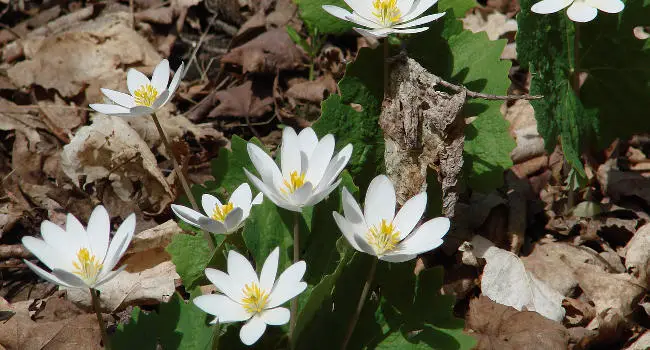

Scientific Name: Sanguinaria canadensis
Level of Toxicity to Dogs: Mild to Moderate
Common Symptoms to Watch For: Vomiting, Tiredness, Dizziness, Vertigo, Organ Failure
The Bloodroot are wildflowers that has some medicinal remedies like treating ringworms and sore throat. While the plant is medicinal to us humans it is extremely toxic to dogs. The entire part of the bloodroot plant is toxic to dogs especially the roots and stems. When ingested they may quickly get poisoned as symptoms include nausea, vomiting, organ failure and even death. It is one of those plants that if your dog eats a part of the plant they require a veterinarian immediately.
Blue-Green Algae


Scientific Name: Cyanobacteria
Level of Toxicity to Dogs: Severe
Common Symptoms to Watch For: Vomiting, Diarrhea, Bloody or black stool, Seizures, Disorientation, Difficulty breathing, Blue discoloration of skin
The Blue-green Algae are most commonly located on rich waters during hot summer months. These plants produces toxins such as microcystins and anatoxins. If a dog drinks or swims from algae contaminated water they are at risk of getting poisoned especially if ingested the results could be liver damage or failure. Signs of these are vomiting, diarrhea, weakness, coma and shock.
Bluebonnet (aka Lupine)


Scientific Name: Lupinus
Level of Toxicity to Dogs: Severe
Common Symptoms to Watch For: Difficulty swallowing, Twitching, Respiratory problems, trembling, loss of muscle control
The Bluebonnet has a unique look because of it's flowers and are commonly seen along the roadsides and blooms along with other wild flowers during spring. These plants have many different kinds of alkaloids as toxins. Every part of the bluebonnet especially the flowers are toxic to dogs and must be treated as a medical emergency if ingested.
Buckeye
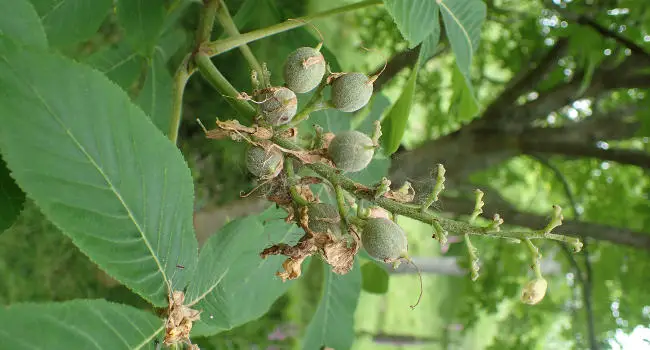

Scientific Name: Aesculus glabra
Level of Toxicity to Dogs: Mild to Moderate
Common Symptoms to Watch For: Drooling, Vomiting, Diarrhea, Staggering, Depression, Tremors, Seizures
The Buckeye Eye tree are mostly found in the Midwest and not so common to other parts of the country. Most parts of the buckeye like the sprout, leaves, nuts and bark are toxic to most animals including dogs. The toxin found in the tree are saponin which are mostly concentrated on the sprouts. Consuming or ingesting any part of the tree can cause extreme irritation to their intestinal system. If a dog is seen eating this tree visit your veterinarian and they should have an IV ready for them and sometimes they have to pump out the toxin from the dog's stomach.
Buttercup
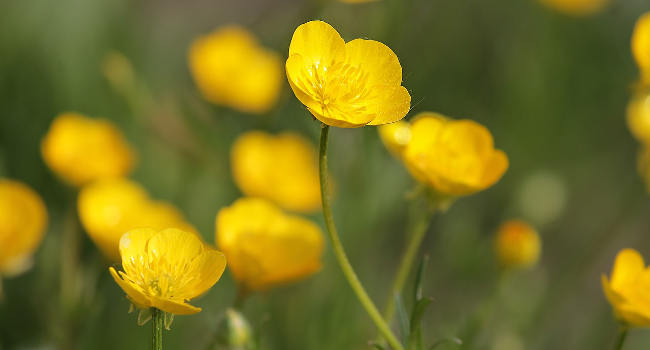

Scientific Name: Ranunculus
Level of Toxicity to Dogs: Mild to Moderate
Common Symptoms to Watch For: Drooling, Vomiting, Diarrhea, Weakness, Blisters in the mouth, Tremors, Seizures, Paralysis (rare)
The Buttercup or Figwort is found mostly in the fields and meadows. These plants have a chemical called ranunculin that are found in the flowers. The chemical will cause poisoning to dogs if it's chewed or crushed in their mouth because the chemical will turn into protoanemonin that is toxic to dogs. Although most dogs would not eat the plant because not only does it taste bad but the oil coming out from the plant when crushed will cause blisters in their mouth and tongue but we will never know as some dogs tend to eat anything.
Caladium
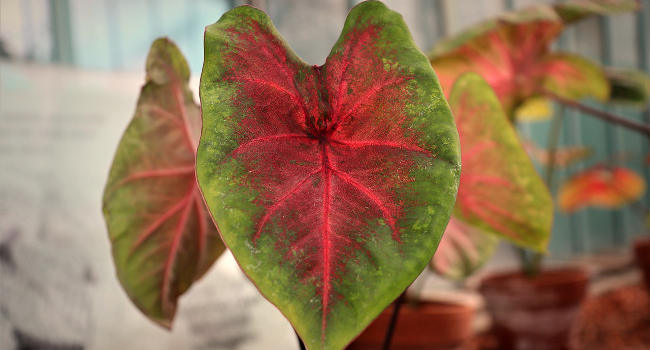

Scientific Name: Caladium
Level of Toxicity to Dogs: Mild to Moderate
Common Symptoms to Watch For: Drooling, Pawing at the mouth, Oral pain, Decreased appetite, Vomiting
The Caladium plant commonly seen among houses as a house plant is also known as angel wings or heart of Jesus. These plants contain insoluble calcium oxalate acid which has crystals that will get into your dog's tissues skin and mouth. These plants can be very toxic to a dog. There are two ways that a dog will get poisoned by the Caladium; one is from eating the plants leaves, root and stalk and the other is exposure of their skin from the oil coming from the plant.
Calla Lily
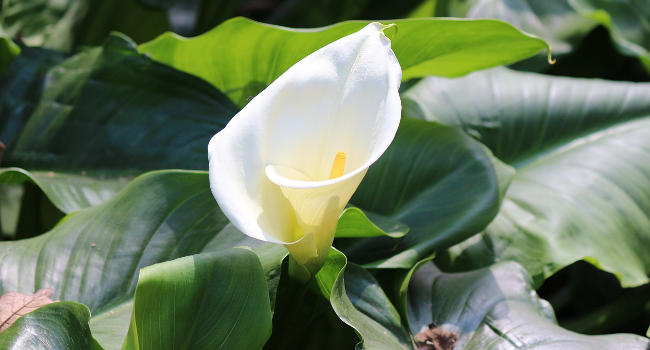

Scientific Name: Zantedeschia aethiopica
Level of Toxicity to Dogs: Mild to Moderate
Common Symptoms to Watch For: Drooling, Oral Pain, Pawing at the mouth, Vomiting, Decreased appetite
The Calla Lilly also known as pig lily, trumpet lily, garden calla, Aaron lily, white arum, florist's calla are beautiful plants that commonly seen in gardens and home as decor. These plants has something in common with the caladium and it contains a insoluble calcium oxalate found all over the plant, if a large amount consumed could be fatal. A dog will be ill or poisoned if it consumes the plant or coming into contact through their skin penetrating their tissue.
Candelabra Cactus
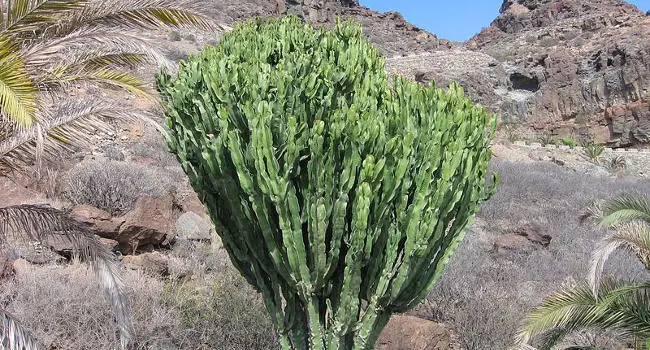

Scientific Name: Euphorbia candelabrum
Level of Toxicity to Dogs: Mild to Moderate
Common Symptoms to Watch For: Drooling, Vomiting, Diarrhea, Skin irritation, Eye irritation
Candelabra cactus also known as euphorbia, mottle spurge, dragon bones, false cactus, and mottled candlestick are usually found outdoors in the garden. The plant contains insoluble calcium oxalate crystals which are found in all parts of the plant. A dog that consumes or just even chew the plant will cause immediate pain in their mouth and if swallowed can cause severe swelling and pain to their gastrointestinal tract.
Castor Bean (aka African Wonder Tree)
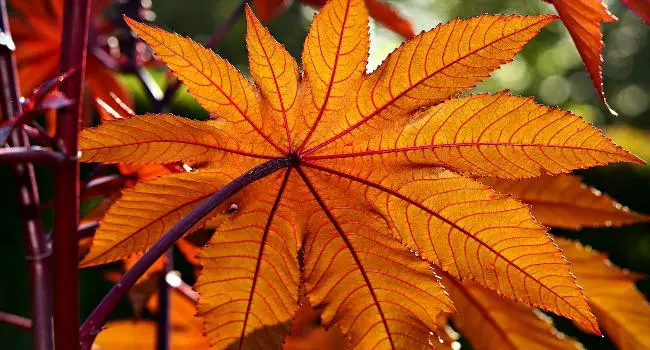

Scientific Name: Ricinus communis
Level of Toxicity to Dogs: Severe
Common Symptoms to Watch For: Drooling, Abdominal pain, Vomiting, Bloody diarrhea, Abdominal straining, Weakness, Trembling, Sudden Collapse
The castor bean has one of the most poisonous toxin in the natural world called ricin. The ricin is mostly concentrated on the seeds. These plants are mainly found in parks and usually used as a decorative plant. When the seed is ingested by dogs contact your veterinarian immediately. Symptoms of ricin poisoning are abdominal pain, abdominal straining, bloody diarrhea, death, dehydration, excessive drooling, hypotension, and increase in temperature, loss of appetite, pain in mouth, sudden collapse, trembling, vomiting and weakness.
Chinaberry Tree
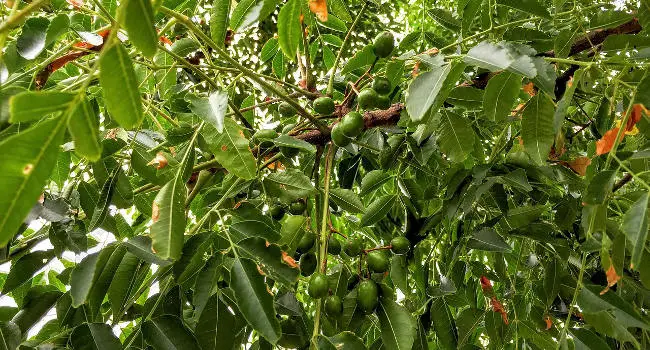

Scientific Name: Melia azedarach
Level of Toxicity to Dogs: Mild to Moderate
Common Symptoms to Watch For: Vomiting, Drooling, Diarrhea, Depression, Seizures
The Chinaberry Tree also known as Persian lilac are toxic to dogs. The tree produces a insecticide that is found in all parts of the plant. The highest concentration of poison are found in the fruit. Poisoning on dogs only occurs when they eat any part of the tree and usually it is the ripened fruit which is where the poison is mostly concentrated. If this happens contact your veterinarian immediately as symptoms may occur in 2 to 4 hours.
Chinese Evergreen
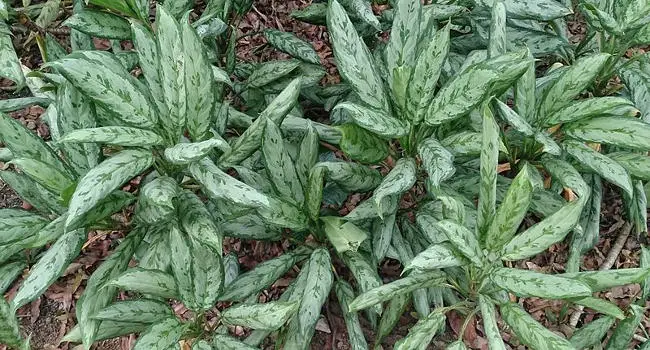

Scientific Name: Aglaonema
Level of Toxicity to Dogs: Mild to Moderate
Common Symptoms to Watch For: Drooling, Pawing at the mouth, Oral pain, Decreased appetite, Vomiting
The Chinese evergreen or Aglaonema are usually found indoors as a houseplant as it does not do well with cold weather. This plant contains a toxin which are quite common to houseplants insoluble calcium oxalate. Every part of the plant is toxic to dogs if chewed or swallowed as the calcium oxalate will cause a burning sensation to their mouth, throat, lips and tongue and if swallowed can cause digestive upsets. A dog usually won't swallow any part of the plant as the irritation of their mouth prevents them but in some cases they swallow it, they will need to go to the veterinarian immediately. Symptoms can occur immediately or up to 2 hours after ingestion and sometimes a week or 2.
Chokecherry
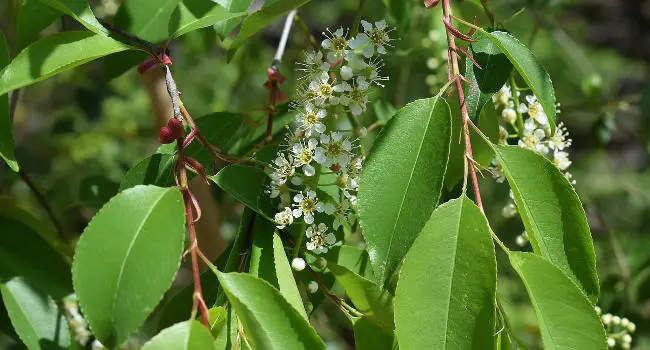

Scientific Name: Prunus virginiana
Level of Toxicity to Dogs: Mild to Moderate
Common Symptoms to Watch For: Dilated Pupils, Difficulty breathing, Red gums, Shock
The Chokeberry are directly related Apple seeds, Black Cherry, Cherry, Peach and Plum. These plants contain cyanide and are very poisonous. Cyanide poisoning occurs if a dog eats the fruit, bark or leaves of the chokeberry and are found usually scattered on the ground. Although a small amount may not cause any big issues but eating more of it is highly toxic and could be fatal if not early. Symptoms may occur in an instant or several hours, contact your nearest veterinarian immediately.
Christmas Rose
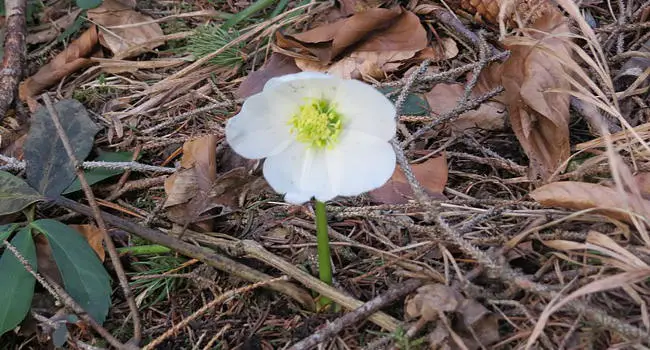

Scientific Name: Helleborus niger
Level of Toxicity to Dogs: Mild to Moderate
Common Symptoms to Watch For: Drooling, Lethargy, Vomiting, Abdominal pain, Diarrhea
The Christmas rose is a beautiful plant that are usually on display during winter season on homes but these plants are highly toxic to dogs. The plant contains glycosides that are toxic to dogs. Poisoning will happen if a dog eats or swallowed any part of the plant from roots to the stems. Although a small amount of ingestion is not serious a big amount of it can be life threatening.
Cordatum
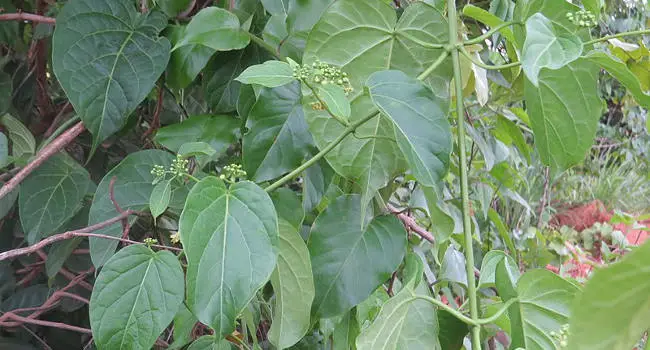

Scientific Name: Philodendron cordatum
Level of Toxicity to Dogs: Mild to Moderate
Common Symptoms to Watch For: Oral irritation, Swelling of the mouth, Excessive drooling, Vomiting, Difficulty swallowing
The Cordatum plant also known as Philodendron, fiddle leaf, panda plant or saddle leaf is a popular houseplant and also found in gardens. This plant contains calcium oxalate crystals which is present all over the plant. The oxalate crystals presents a danger to dogs as this crystals if ingested can cause intense pain to the dog’s mouth, lips and tongue. The pain from their tongue can make their breathing difficult and will reach to dangerous levels. It does not only stop there if the dogs eyes and skin are exposed they will suffer irritation as well.
Cowbane
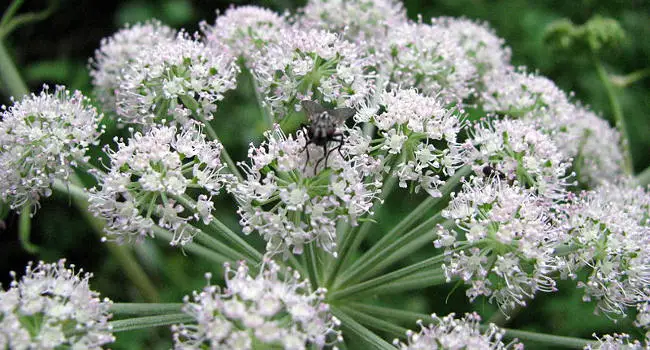

Scientific Name: Cicuta virosa
Level of Toxicity to Dogs: Severe
Common Symptoms to Watch For: Drooling, Dilated pupils, Weakness, Agitation, Nervousness, Twitching, Seizures, Difficulty breathing
Cowbane also known as northern water hemlock or McKenzie water hemlock are usually found along wetlands or fields. The plant contains toxins called cicutoxin that are highly poisonous to animals even a small amount such as a single bite from the root is considered lethal. When doing hiking or for walks be aware of these plants as dogs tend to eat shoots or leaves. Contact your veterinarian or go to your nearest animal hospital if you found your dog eating parts of the plant as symptoms will appear immediately and can cause death in a matter of hours.
Crocus


Scientific Name: Crocus
Level of Toxicity to Dogs: Severe
Common Symptoms to Watch For: Drooling, Vomiting, Bloody diarrhea, Decreased appetite, Black stool, Organ damage, Respiratory failure, Seizures
The Crocus plants have two different types, spring crocus and the autumn crocus also known as naked lady. The spring crocus has a mild to moderate poisoning that isn't known to be fatal to dogs but the one to watch out for is the autumn crocus which contains a poison called colchicine which is fatal to dogs as it causes gastrointestinal distress. A dog can be poison by eating any part of the autumn crocus and symptoms may occur immediately or several hours. A visit to the animal hospital or contacting your nearest veterinarian if a dog eats this plant.
Cyclamen


Scientific Name: Cyclamen persicum
Level of Toxicity to Dogs: Mild to Moderate
Common Symptoms to Watch For: Vomiting, Drooling, Diarrhea, Abnormal heart rate, Seizures
Cyclamen also known as Persian violet is a beautiful plant that is quite common in homes. These plants contain a poisonous toxin called saponins that can cause serious poisoning to dogs. The way the dog get poisoned by cyclamen is by chewing and eating the plant. The flowers of the plant can cause mild poisoning but the tubers of the plant where saponins are concentrated can be extremely toxic to dogs.
Dogbane
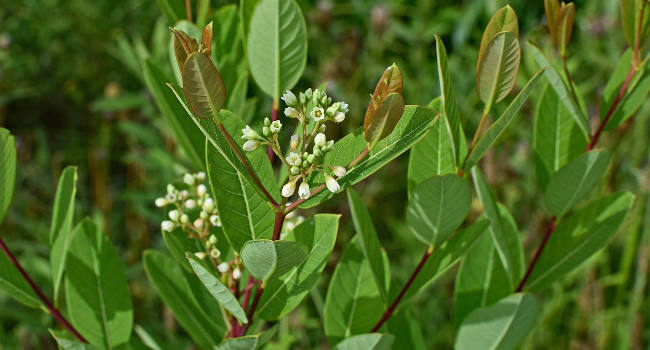

Scientific Name: Apocynum cannabinum
Level of Toxicity to Dogs: Severe
Common Symptoms to Watch For: Vomiting, Drooling, Nausea, Vomiting, Abnormal heart rate, Collapse, Weakness, Dilated pupils, Tremors, Seizures
The Dogbane or Apocynum cannabinum which also means "away dog" is a shrub like plant that grows on roadsides and woodlands. The plant contains cardiac glycosides than can cause gastrointestinal upsets and heart problems. During hikes or long walks be aware of these plants as some dogs like to chew and eat plants, any part of the plant is extremely toxic and considered to be life threatening.
Elderberry
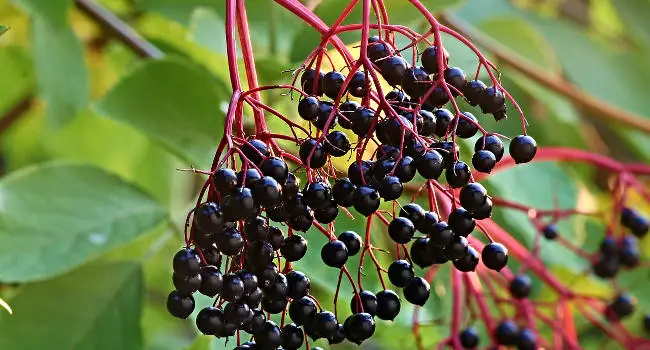

Scientific Name: Sambucus
Level of Toxicity to Dogs: Mild to Moderate
Common Symptoms to Watch For: Diarrhea, Excessive drooling, Seizures, Shaking, Vomiting
The Elderberry plants are widely used to make wine or tea but these plants and its many varieties are highly toxic to dogs. These plants contain cyanogenic glycoside all over the plant especially if the berries are not ripe. Ripe berries are less toxic but still with large amount could be poisonous. Symptoms of elderberry poisoning is fast and deadly as early as 30-45 minutes your dog might be in life threatening situations. If you see your dog eating the plant, immediately contact your veterinarian or better to go to your nearest animal hospital for treatment as this type of poisoning requires immediate medical attention.
Fern
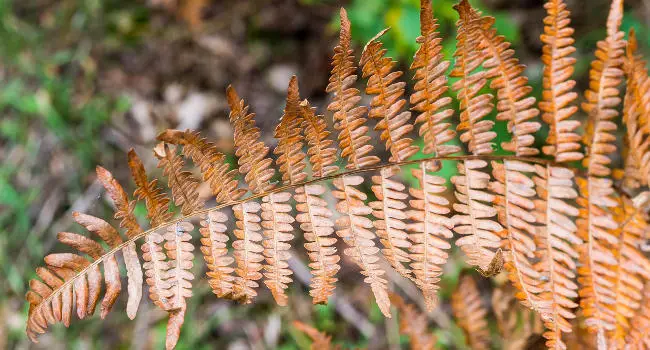

Scientific Name: Polypodiopsida
Level of Toxicity to Dogs: Mild to Moderate
Common Symptoms to Watch For: Diarrhea, Pain, Vomiting
Fern plants are commonly seen on gardens, homes and backyard and have many different types. These plants are hard to distinguish if the type are nontoxic or toxic to dogs because these plants have several similarities in how they look. One of the toxic type of fern is the emerald fern although it may only cause mild to moderate poisoning to dogs. If consumed or ingested the plant causes vomiting, diarrhea and abdominal pain.
Foxglove
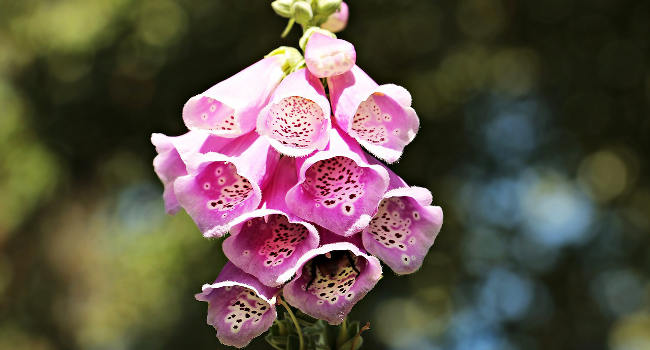

Scientific Name: Digitalis
Level of Toxicity to Dogs: Severe
Common Symptoms to Watch For: Drooling, Nausea, Vomiting, Abnormal heart rate, Cardiac arrhythmias, Weakness, Collapse, Dilated pupils, Tremors, Seizures
A very popular and beautiful plant because of its trumpet-like blossoms commonly found in homes and gardens is the Foxglove plant. These plants are highly toxic to dogs so owners should be aware as its poison can affect the heart of your dog. The poisonous content that is found all over the plant is called cardiac glycoside. Symptoms are nausea, tremors, abdominal pain, dilated pupils and even death. Eating or even just chewing the plant is lethal and should be treated as a medical emergency.
Gopher Purge
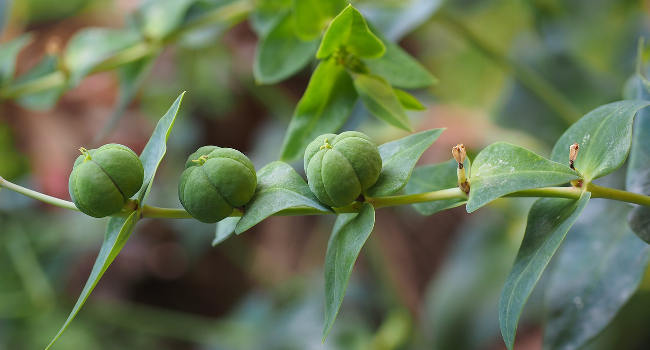

Scientific Name: Euphorbia lathyris
Level of Toxicity to Dogs: Mild to Moderate
Common Symptoms to Watch For: Drooling, Diarrhea, Skin irritation, Eye irritation
The Gopher Purge also known as gopher spurge or mole plant are usually seen in gardens or farms to repel moles and rodents. These plants contain saponins and are toxic to dogs. Consuming or ingesting any part of the plant is how a dog would get poisoned from the plant. The sap of the plant can also cause sever skin irritation when exposed to a dog's skin. Although eating the plant is not life threatening to dogs but there are instances that dogs have consumed a large amount of the plant and this requires immediate medical treatment and should not be taken lightly.
Hemlock (aka Poison Hemlock)
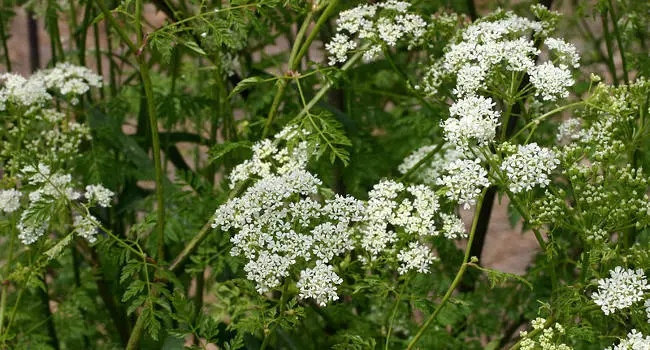

Scientific Name: Conium maculatum
Level of Toxicity to Dogs: Severe
Common Symptoms to Watch For: Diarrhea, Anemia, Lethargy, Seizures, Shaking, Vomiting
The Poison Hemlock are tall summer flowering plants that sometimes can be mistaken as water hemlock by name and both are very toxic to dogs. The plant contains alkaloids known as coniine that are present all over the plant. Dogs are usually deterred from eating the plant as it could cause intense pain in their mouth but if a dog has consumed the plant they would need medical help from a veterinarian as symptoms may occur immediately. The poison attacks the dog’s nervous system, kidney and lungs causing serious health problems.
Holly
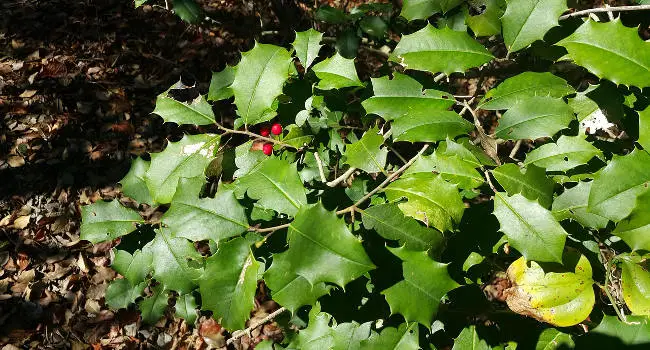

Scientific Name: Ilex
Level of Toxicity to Dogs: Mild to Moderate
Common Symptoms to Watch For: Lip Smacking, Drooling, Head shaking, Vomiting, Diarrhea, Decreased appetite
American holly also known as holly plants are popular decorations during christmas time. The plants leaves and berries if ingested by dogs are generally not fatal but consuming several may cause gastrointestinal distress, such as vomiting and diarrhea.
Horse Chestnut
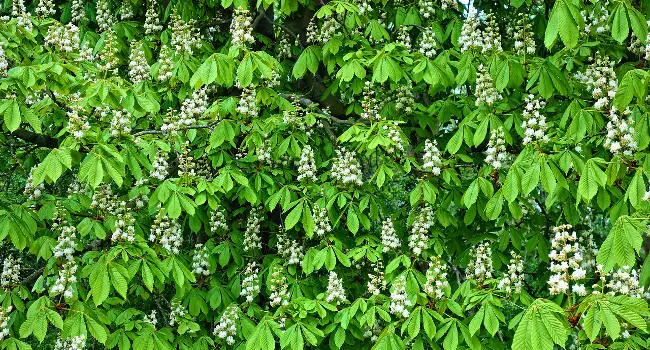

Scientific Name: Aesculus hippocastanum
Level of Toxicity to Dogs: Mild to Moderate
Common Symptoms to Watch For: Seizures, Depression, Vomiting, Shaking, Anemia, Diarrhea
The Horse Chestnut tree are found all over the world and during autumn drops dark brown nuts that commonly known as conkers. The tree's bark, leaves and flowers are toxic to dogs including the nuts as they contain a deadly toxin called aesculin. The toxin causes tremors, vomiting and even sudden death if not treated immediately as symptoms may occur within 1 to 6 hours and will go on up to 2 days.
Jack-in-the-Pulpit
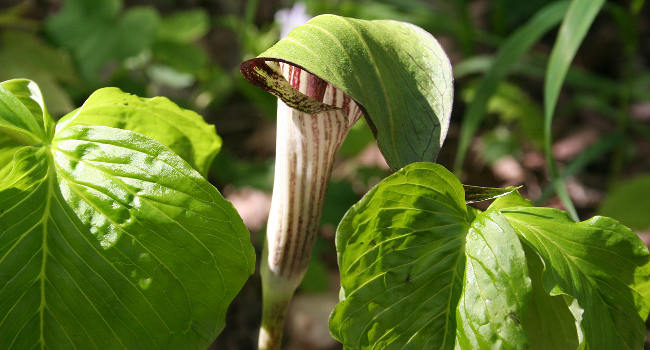

Scientific Name: Arisaema triphyllum
Level of Toxicity to Dogs: Mild to Moderate
Common Symptoms to Watch For: Drooling, Pawing at the mouth, Oral pain, Decreased appetite, Vomiting
The Jack-in-the-Pulpit are plants found in the wild that hikers who brings their dog hiking should be aware. These plants are highly toxic to dogs as it contains calcium oxalate crystals that when chewed can cause intense pain and irritation of the mouth. Dogs deter from further eating these plants as the pain is almost instant but there are some cases that they may eat a large amount of the plant. The toxins can be found in every part of the plant and if ingested could cause gastrointestinal tract problems.
Locoweed
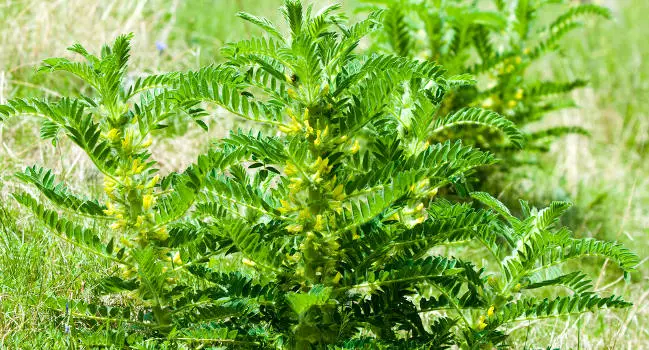

Scientific Name: Astragalus
Level of Toxicity to Dogs: Mild to Moderate
Common Symptoms to Watch For: Seizures, Lethargy, Shaking, Vomiting, Diarrhea, Collapse
Locoweed or crazyweed gotten from the Spanish word loco meaning crazy are the most common livestock poisoning plant in the western United States. These plants contain Swainsonine and found in all parts of the locoweed. Poisoning could be mild to severe depending on the amount a dog has eaten or ingested the plant. Continuing of eating of locoweed could also cause a medical condition called locoism or swainsonine disease which causes aggression, blindness, hyperactivity, weakness and possible death. Contacting your veterinarian as soon as possible if you find your dog eating these plants.
Mayapple
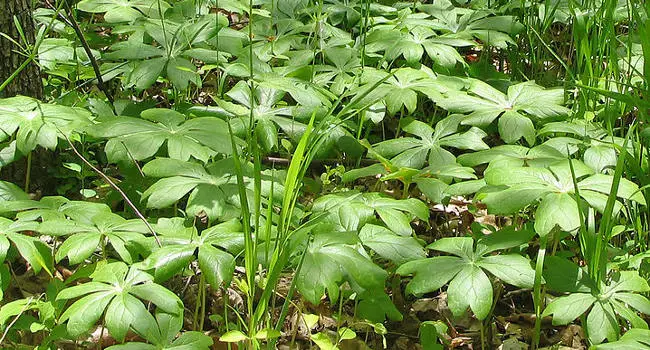

Scientific Name: Podophyllum peltatum
Level of Toxicity to Dogs: Mild to Moderate
Common Symptoms to Watch For: Drooling, Vomiting, Diarrhea, Skin irritation
Mayapple also known as American mandrake or wild mandrake are woodland plants most common in the United States and southeastern Canada. All parts of the Mayapple plant is poisonous to dogs including the unripe green fruit. The ripened fruit is edible and non toxic if eaten in small amounts. Vomiting, diarreha, irritation of the skin are the common symptoms of dogs eating the plant and would require treatment by your veterinarian.
Milkweed
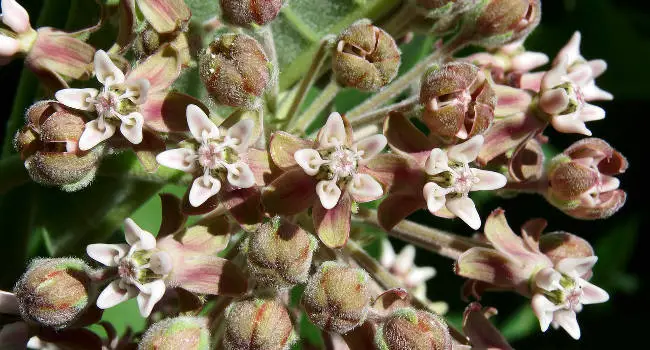

Scientific Name: Asclepias
Level of Toxicity to Dogs: Severe
Common Symptoms to Watch For: Drooling, Nausea, Vomiting, Abnormal heart rate, Cardiac arrhythmias, Weakness, Collapse, Dilated pupils, Tremors, Seizures
These plants contain several toxins namely galitoxin and cardiac gylcosides. The sap of the milkweed has high concentration of cardiac glycosides. Ingesting the sap will cause tremors, nervousness and seizures. Milkweed poisoning should be treated as an urgent matter. Symptoms are cardiac arryhythmias, collapse, decreased heart rate, depression, diarrhea, drooling, hyperkalemia, increased heart rate, loss of appetite, lethargy, nausea, nervousness, seizures, sudden death, tremors, unsteady gait, vomiting and weakness.
Mistletoe
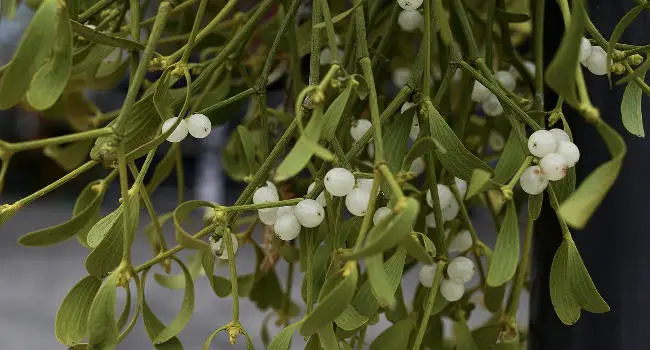

Scientific Name: Phoradendron leucarpum
Level of Toxicity to Dogs: Mild to Moderate
Common Symptoms to Watch For: Drooling, Vomiting, Diarrhea, Abdominal pain, Hypotension, Staggering, Collapse, Seizures
Mistletoe plants are shrub like structure that attaches on a host tree and are called parasitic plant. These plants are common during the holiday season and should always be out of reach from your dogs. Causes of mistletoe poisoning is when your dog eats any part of the plant. A small amount of ingested causes diarrhea, vomiting and abdominal pain and a large amount of ingestion will result in low blood pressure, seizures and even death. It is considered a medical emergency when you see your dog eating the mistletoe plant and should be taken to the nearest animal hospital especially if large amounts have been ingested.
Monkshood
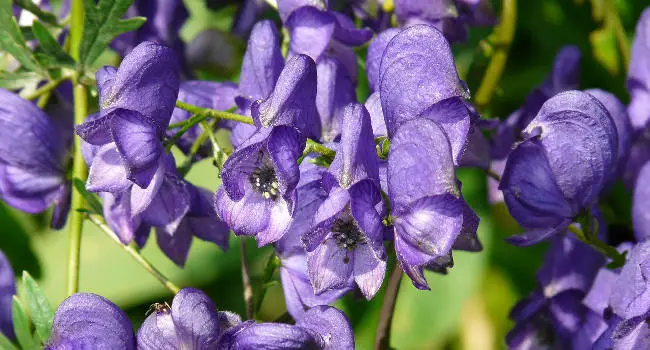

Scientific Name: Aconitum
Level of Toxicity to Dogs: Severe
Common Symptoms to Watch For: Weakness, Heart arrythmias, Paralysis, Tremors, Seizures
Monkshood also known as wolfs bane, aconite, leopards bane or queen of poisons are flowering plants commonly found in the wild but some are used by florists. These plants are highly toxic and dogs should never be near on these plants when you have them at your home. Although dog's to tend to stay away from these plants because of the smell and chewing on the plants causes intense pain in their mouth. There are still curious dogs who will try to eat the plant and only a small dose of the toxin found all over the plant could cause severe illness to a dog. Treatment is required as soon as possible by your veterinarian when you see your dog eating a monkshood plant.
Mountain Laurel
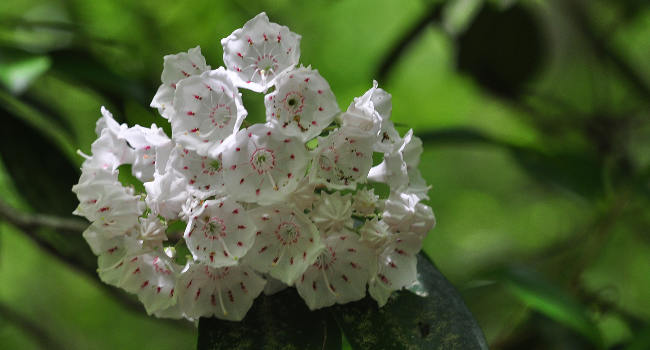

Scientific Name: Kalmia latifolia
Level of Toxicity to Dogs: Severe
Common Symptoms to Watch For: Vomiting, Excessive drooling, Diarrhea, Arrhythmias, Tremors, Possible Coma
The Mountain Laurel also known as calico bush or spoonwood are evergreen shrubs that are native to the United States. These plants are poisonous to dogs and several other animals due to the harmful toxin in the plant called grayanotoxin. Eating any part of the plant can cause serious illness and must be treated as soon as possible. Symptoms may include paralysis, muscular spasms, tremors, weakness and more.
Pencil Cactus
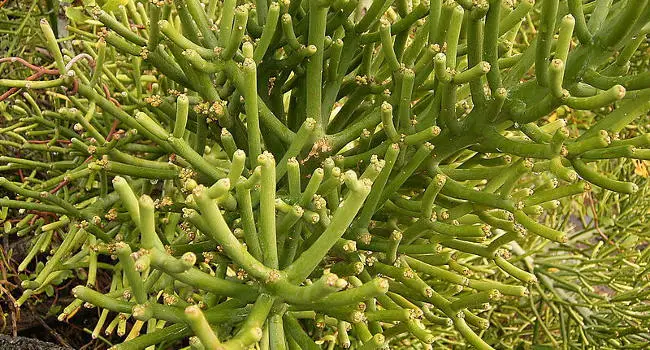

Scientific Name: Euphorbia tirucalli
Level of Toxicity to Dogs: Mild to Moderate
Common Symptoms to Watch For: Drooling, Vomiting, Diarrhea, Skin irritation, Eye irritation
The Pencil Cactus is a cactus like tree that is also known as pencil tree. These plants are often used by gardeners to ward of wildlife in their garden as it is toxic to dogs and other animals. Poisoning occurs when a dog tries to bite or chew the on the plant and the sap spills out toxin that could cause intense pain in their mouth, irritation of the skin when exposed and even harm their eyes when it comes into contact. Treatment on the expose skin should be washed by soap thoroughly and if pain is still present should be taken to your nearest veterinarian for additional treatment especially if exposed in the eyes or ingested the plant.
Poison Ivy
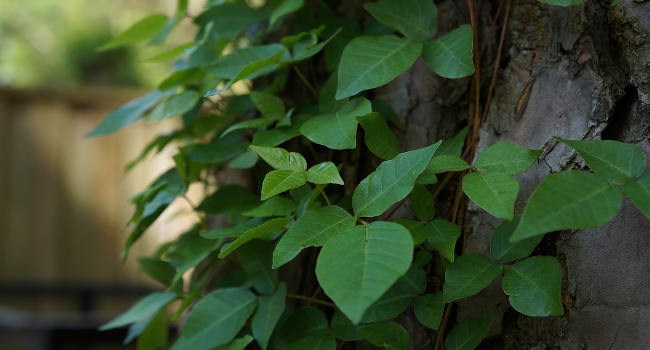

Scientific Name: Toxicodendron radicans
Level of Toxicity to Dogs: Mild to Moderate
Common Symptoms to Watch For: Skin reddening, Swelling and itching at the point of skin/urushiol contact, Fluid filled vesicles and scabs may also form on the skin, Abdominal pain, vomiting, Diarrhea
When going for walks in areas with lots of plants poison ivy is a concern for most dog owners. Poison ivy doesn't affect dogs as often as humans as their fur coats helps protect their skin. Dogs who eat the ivy plant is a different story as they may suffer from gastrointestinal upset. Symptoms or signs that your dog may be suffering from ivy poisoning are red skin, itching/inflammation, raised bumps, blisters or scabs, vomiting and diarrhea.
Poison Oak
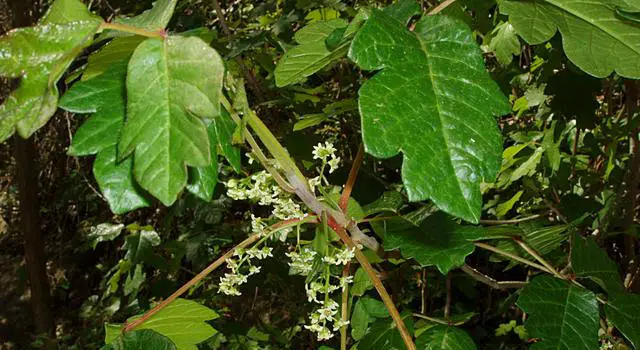

Scientific Name: Toxicodendron diversilobum
Level of Toxicity to Dogs: Mild to Moderate
Common Symptoms to Watch For: Abdominal pain, Constipation, Diarrhea, Depression, Frequent urination, Discolored urine
The Poison Oak are shrub like plant often being mistaken as poison ivy because of it's similarity that grows leaves of three. The difference is the shape of the leaves and sometimes the plant has white yellow berries. These plants usually cannot penetrate the dog's skin because of the fur or coat, but there are some cases it would and these causes severe irritation of the skin such as rash and blistering. These toxin could also transfer to the us when rubbing the dog's coat where the toxin has been on. Be aware when doing walks or hikes with your pet just as the poison ivy they could grow in unexpected areas.
Pokeweed
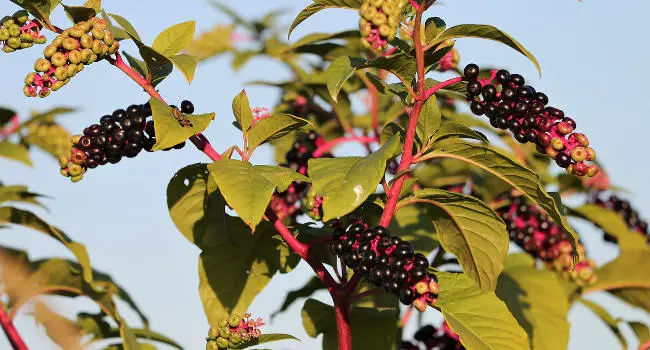

Scientific Name: Phytolacca decandra
Level of Toxicity to Dogs: Mild to Moderate
Common Symptoms to Watch For: Drooling, Vomiting, Refusal of food, Diarrhea, Possible tremors, Hypotension
Pokeweed also known as pokeberry are native to the United States and known to be poisonous to both humans and dogs. Every part of the pokeweed plant is toxic especially the rootstock as it has the highest concentration of poison. The plant should never be in a dog's reach or even children as they may get attracted to the plants berries which carries the poison if eaten. It is a medical emergency if you see your dog eats’ any part of the plant as it could be fatal if not treated as soon as possible.
Poppy


Scientific Name: Papaver somniferum
Level of Toxicity to Dogs: Mild to Moderate
Common Symptoms to Watch For: Decreased appetite, Sedation, Staggering, Coma, Slowed breathing, Slowed heart rate, Pinpoint pupils
Poppy plants are wildly popular as this plant has been featured in movies like wizard of oz when Dorothy fell asleep in a field of poppy's. These plants have many different species but all of them are toxic to dogs if ingested because it contains alkaloids that could be fatal if not treated. Every part of the plant is toxic except for the seeds but it is still advisable not to let your dog eat it. Medical treatment is needed as soon as possible if a dog eats these plants.
Precatory Bean
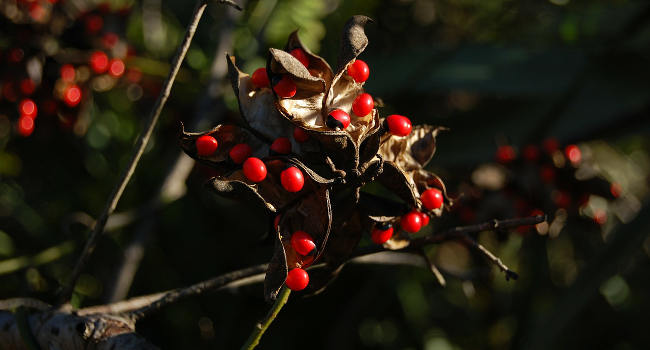

Scientific Name: Abrus precatorius
Level of Toxicity to Dogs: Severe
Common Symptoms to Watch For: Vomiting, Diarrhea, Bloody vomitus, Elevated heart rate, Abdominal pain, Shock
Precatory Bean also known as rosary pea are known for its seeds in making rosary beads and percussion instruments. These plants are highly toxic as it contains toxic content abrin and abric acid. Chewing or ingesting the plant especially the seeds where the toxin is mostly concentrated could cause serious health problem to dogs. Early symptoms are usually vomiting and diarrhea with some presence of blood and if not treated early could result to death. It is best to contact your veterinarian when you see your dog eating the precatory bean.
Privet
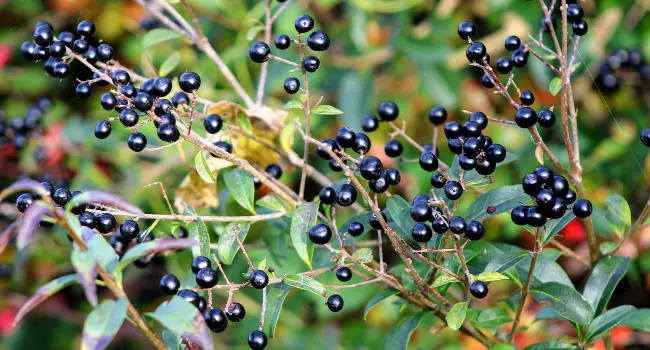

Scientific Name: Ligustrum
Level of Toxicity to Dogs: Mild to Moderate
Common Symptoms to Watch For: Vomiting, Diarrhea, Refusal of food, Incoordination, Increased heart and respiratory rate
Privet plants are commonly used as a garden hedge to provide privacy in our homes because of dense foliage. These evergreen shrub are toxic to dogs depending on the amount they have ingested. Every part of the plant is poisonous including the berries it produce. Causes of poisoning are usually when dogs goes in to the foliage and eats the berries of plant or chews on the leaves causing some part of the plant being ingested.
Scotch Broom
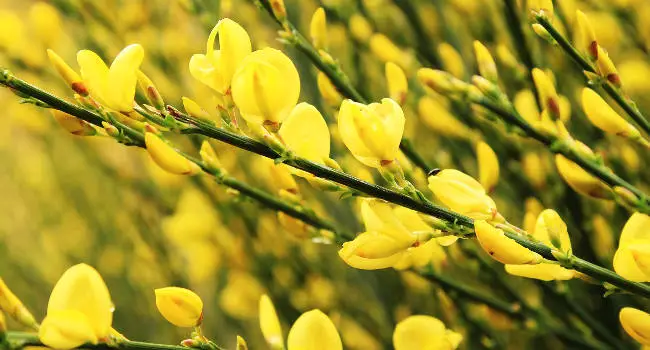

Scientific Name: Cytisus scoparius
Level of Toxicity to Dogs: Mild to Moderate
Common Symptoms to Watch For: Vomiting, Abdominal discomfort, Weakness, Staggering, Increased heart rate
Scotch Broom plants are invasive evergreen shrubs that produces attractive yellow flowers and also used as an ornamental shrub. The plant is toxic to dogs because of several alkaloids found in the plant causing harmful effects. Be aware of these plants when doing walks in the parks or fields as dog tend to play and chew on these plants. Toxicity is dependent on how much the amount the dog has ingested and will require a visit to a veterinarian for treatment.
Shamrock
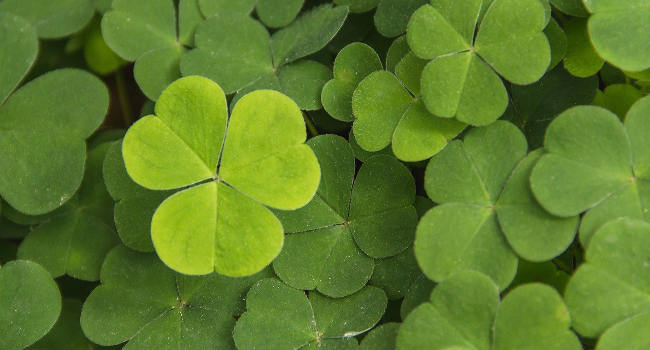

Scientific Name: Trifolium repens
Level of Toxicity to Dogs: Mild to Moderate
Common Symptoms to Watch For: Drooling, Staggering, Vomiting, Diarrhea, Lethargy, Weakness, Tremors, Bloody urine, Changes in thirst and urination
Shamrock plants are popular plants that are usually often found indoors in a pot and have clover like leaves that many people think that it brings good luck. The plant is toxic to dogs because it contains soluble calcium oxalate crystals that affects the bloodstream. The plant is bitter to eat or chew so most dogs deter from a large amount of the plant. Symptoms of poisoning could be mild like diarrhea and excessive salivation but if consumed in large amounts could damage a dog's kidney. Fortunately fatality in shamrock poisoning is rare and a visit to the veterinarian for treatment could help on a speedy recovery.
Skunk Cabbage
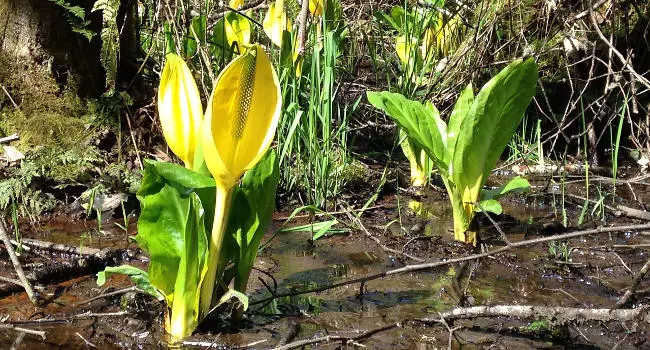

Scientific Name: Symplocarpus foetidus
Level of Toxicity to Dogs: Mild to Moderate
Common Symptoms to Watch For: Drooling, Pawing at the mouth, Oral pain, Decreased appetite, Vomiting
Skunk Cabbage are wildflowers that grows in swampy areas and although the plant produces a stinky smell some gardeners tend to use them on their gardens to attract beneficial insects such as bees and butterflies. These plants if you have them on your garden or doing hiking in the woods with your dog should never be consumed or eaten by your dog. The plant contains insoluble calcium oxalate crystals which are all over the plant. These crystals could cause intense pain and irritation of the mouth if chewed or ingested by dogs. Applying or rinsing the dog’s mouth with water is one way to help relieve the pain and offering cold water to drink. If ingested in large amounts requires a visit to the veterinarian especially if they already are showing signs of difficulty in breathing as these crystals could obstruct the airway.
Snowdrops


Scientific Name: Galanthus
Level of Toxicity to Dogs: Mild to Moderate
Common Symptoms to Watch For: Drooling, Vomiting, Abdominal pain, Diarrhea, Staggering, Drop in blood pressure and heart rate, Seizures
Snowdrops or snowdrop flower bulbs are tiny flowering plants that has white flowering bulbs hanging and commonly seen during spring. These plants contain a phenanthridine alkaloids which are found all over that if consumed is poisonous to dogs. The most potent where the alkaloids are mostly concentrated are in the bulbs and is what dogs tend to chew on first. These causes symptoms like drooling, vomiting, diarrhea and if sever causes seizures. Although the toxin in the bulb is mild to moderate it is best to visit your veterinarian for treatment as there is no antidote for this type of alkaloid.
Star of Bethlehem
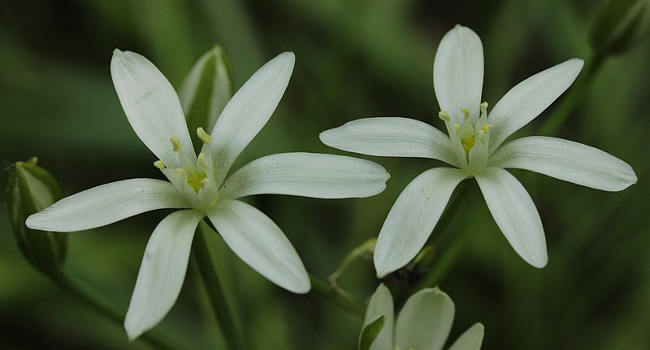

Scientific Name: Ornithogalum
Level of Toxicity to Dogs: Severe
Common Symptoms to Watch For: Drooling, Nausea, Vomiting, Abnormal heart rate, Cardiac arrhythmias, Weakness, Collapse, Dilated pupils, Tremors, Seizures
Star of Bethlehem is similar looking to wild onions but has no smell. It is an attractive and often used as a bedding plant in gardens. The plant is toxic in every part as it contains cardiac glycosides that causes cardiac failure. Causes of poisoning is when dogs tend to eat the flowers or any part of the plant and depending on the amount they consume could be mild to severe poisoning resulting to death. Dogs need to see a veterinarian as soon as possible if you see your dog eating the star of Bethlehem to induce vomiting to expel the toxins from the stomach.
Stinging Nettle
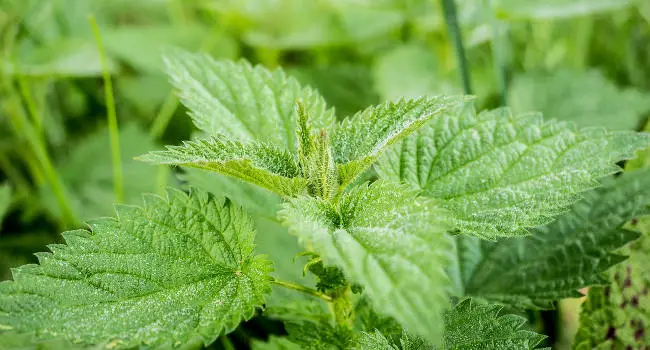

Scientific Name: Urtica dioica
Level of Toxicity to Dogs: Mild to Moderate
Common Symptoms to Watch For: Redness, Swelling, Intense itching, Drooling, Pawing at the mouth, Vomiting, Labored breathing, Twitching, Staggering
Stinging Nettle or common nettles are plants mostly found in uncultivated areas and can grow up to 3 to 7 feet tall. The plants leaves and stems are covered with little hairs that contains chemicals causing swelling and intense itching when rub to a dogs exposed skin. Most dogs stay away from these plants because of the pain it can do to their skin but there have been cases when some dogs will run around on the fields and breathing in the hair of the stinging nettle causing intense pain in their nasal passage making breathing difficult because of the swelling. Fortunately majority of stinging nettle poisoning results in dermatitis only and treatment such as washing the area gently with water in the affected area helps. If the pain is too severe do not hesitate to bring your dog to a veterinarian for additional advice and treatment.
Sweet Pea


Scientific Name: Lathyrus odoratus
Level of Toxicity to Dogs: Mild to Moderate
Common Symptoms to Watch For: Weakness, Lethargy, Tremors, Seizures
Sweet Pea plants are flowering plants that are known for its color diversity and fragrance. These plants are popularly used in gardens and bouquets. These plants have different types but all of them are poisonous to dogs and other small animals. The plant contains a toxic chemical that causes musculoskeletal and central nervous system problems. These poison is tricky when it comes to looking for signs of toxicity if eaten because symptoms may not show up for several days. It is recommended to bring your pet for a checkup especially if you see them eating these plants. Continuous eating of the sweet pea could result to severe illness of your dog and even death.
Taro Vine (aka Money Plant)
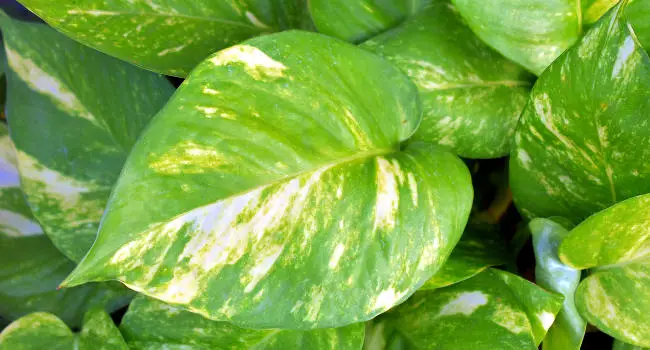

Scientific Name: Epipremnum aureum
Level of Toxicity to Dogs: Mild to Moderate
Common Symptoms to Watch For: Drooling, Pawing at the mouth, Oral pain, Decreased appetite, Vomiting
Taro Vine is part of the araceae family and has many names but the best way to know or distinguished is by looking at its leaves having yellow and green with the green outlining yellow. As part of the araceae family it contains a toxin called insoluble calcium oxalate crystals. The plant if chewed or eaten causes intense pain immediately in a dog's mouth and may block a dog's air passage due to swelling. Dogs deter from ingesting these plants but there are some cases dogs would ingest the plant and these will cause more serious health problems. Dogs need to be taken to a veterinarian immediately so it could be treated early and not cause further medical issues.
Virginia Creeper
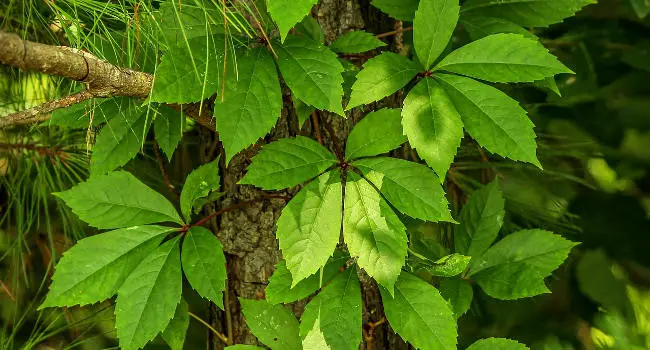

Scientific Name: Parthenocissus quinquefolia
Level of Toxicity to Dogs: Mild to Moderate
Common Symptoms to Watch For: Diarrhea, Excess drooling, Poor appetite, Seizures, Swelling, Vomiting
The Virginia Creeper also known as Victoria creeper, five-leaved ivy or five-finger is part of the grape family. These plants can sometimes be miss identified as poison ivy. The difference between the two are the leaflets as the Virginia creeper has 5 leaflets instead of 3. These plants contain calcium oxalate crystals found all over the plant causing intense pain and irritation when chewed or ingested by dogs. Dogs deter from these plants after chewing it because of the pain they would feel almost immediately. There are some cases when dogs will ingest or swallow these plants causing more serious health problems affecting their gastrointestinal system. An immediate visit to the veterinarian is advice to further treat your dog when you see them eating these plants.
Water Hemlock
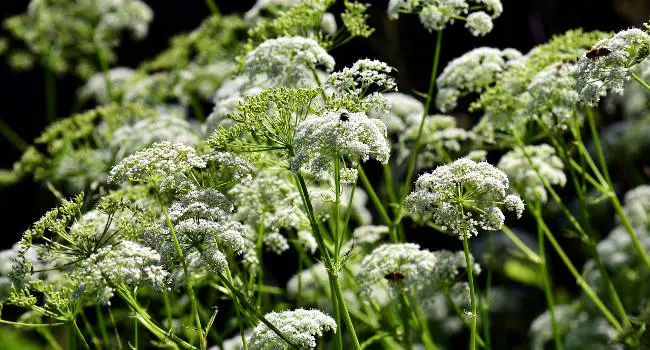

Scientific Name: Cicuta
Level of Toxicity to Dogs: Severe
Common Symptoms to Watch For: Drooling, Dilated pupils, Weakness, Agitation, Nervousness, Twitching, Seizures, Cardiac abnormalities, Difficult breathing
The Water Hemlock is a plant mostly found in wet areas such as streams, meadows and ditches. These plants is considered to be the most toxic plant found in North America according to the USDA. The plant is toxic all over and a small amount of toxin if ingested could cause seizures and death in a few minutes or hours. It's been advice not to take time and wait for symptoms to appear when you find your dog eating these plants. Consider it as a medical emergency and needs to be taken to your nearest animal clinic for treatment.
Wisteria


Scientific Name: Wisteria
Level of Toxicity to Dogs: Mild to Moderate
Common Symptoms to Watch For: Staggering, Vomiting, Diarrhea, Collapse
Wisteria Plants is an attractive plant and gives a great smell especially when in bloom. These plants are quite common in gardens and yards that dogs need to stay away from. The plant is toxic to both humans and dogs. It contains toxins such as lectins and glycosides all over the plant. The seed or pods of the plant is the most dangerous part of the plant as the toxins are more concentrated and more likely what a curious dog would try to eat. Symptoms may cause vomiting nausea and dehydration to the point of collapse. If you see your dog eating from these plants immediately contact your veterinarian and ask for advice, as this is a type of poison needs immediate medical treatment.
Yew
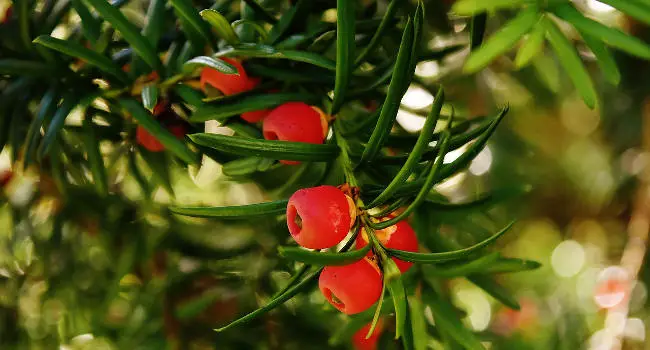

Scientific Name: Taxus baccata
Level of Toxicity to Dogs: Severe
Common Symptoms to Watch For: Drooling, Vomiting, Weakness, Difficulty, Breathing breathing, Life-threatening changes in heart rate and blood pressure, Dilated pupils, Tremors, Seizures, Coma
Yew plants have many names and many kinds of species such as yew plum pine, fern pine, yew pine, japanese pine, southern pine. These are some of the most common yew plants and toxicity to dogs can be mild to severe depending on the amount consumed and the kind of yew tree your dog ingested. The plant is toxic in any part especially the fruit has more concentrated toxin and most likely to be the culprit of poisoning a dog as they might find them tasty to eat. If you see your dog eating the plant contact your veterinarian and bring some sample of the plant he ate to make the treatment and diagnosing faster.
Yucca
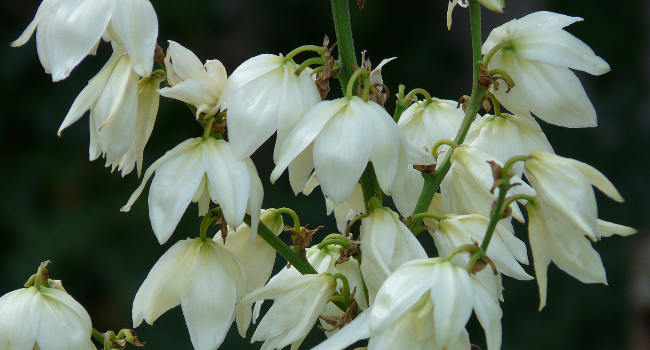

Scientific Name: Yucca filamentosa
Level of Toxicity to Dogs: Mild to Moderate
Common Symptoms to Watch For: Drooling, Vomiting, Weakness, Incoordination
Yucca plants is a desert plant that has long pointed leaves with white flowers that can be found in gardens. These plants contain a toxin called steroidal saponins. The toxins are found in the entire plant and chewing or eating the plant will cause mild to severe poisoning depending on the amount consumed. Fortunately the plant taste bitter or foul that dogs tend to deter after taking a quick bite causing minor to mild poisoning. If large amounts has been consumed will cause life threatening situations as the toxins affect the central nervous systems, intestinal irritation and even death if not treated immediately, an immediate animal clinic or veterinarian is needed if you see your dog eating a large amount of the plant and bring a part of the plant to hasten the process of treatment.
